- Specialized
- Bridge Bikeworks
- Brooklyn Bicycle Co.
- Bunch Bikes
- CYCLE OF GOOD
- DALLINGRIDGE
- Diamondback
- Eddy Merckx
- Electric Bike Company
- EVO Bicycles
- Fahrradmanufaktur
- Flyer by Radio Flyer
- iGO Electric
- Intense 951
- JupiterBike
- Lectric eBikes
- LeMond Bicycles
- Lightweight
- View all brands
- Pivot Cycles
- Qualisports
- Quintana Roo
- Rad Power Bikes
- Raleigh Electric
- Riese & Müller
- Rocky Mountain
- Schindelhauer
- State Bicycle Co.
- Surface 604
- Urban Arrow
- Van Nicholas
- VELO DE VILLE
- Vintage Electric
- Yeti Cycles
- YT Industries


Trek FX 2 Disc
- AUS $ NZD $ USD $ CAD $ GBP £ EUR €
Size / SM, MD, LG, XL, XXL
At a glance
Where to buy.

Specifications
- Frame Alpha Gold Aluminum, DuoTrap S compatible, internal cable routing, flat mount disc, rack & fender mounts, 135x5mm QR
- Fork FX Alloy, flat mount disc, rack mounts, 405 mm axle-to-crown, ThruSkew 5mm QR
- Hubs Formula DC-22, alloy, 6-bolt, Shimano 8/9/10 freehub, 135x5mm QR
- Wheels Bontrager Connection, alloy, double-wall, 32-hole, schrader valve
- Spokes 14g stainless steel
- Tires Bontrager H2 Comp, wire bead, 30tpi, 700x35c
- Chain KMC Z7
- Crank Forged alloy, 48/38/28, chainguard, 170mm length
- Front Derailleur Shimano Tourney TY710, 34.9mm clamp, top swing, dual pull
- Rear Derailleur Shimano Acera M360, long cage
- Shifters Size: S, M, L, XL, XXL, Shimano Altus M310, 8 speed; Size: S, M, L, XL, XXL, Shimano Altus M315, 8 speed
- Brakeset Tektro HD-R280 hydraulic disc, flat mount, 160mm rotor
- Handlebar Size: S, M, Bontrager alloy, 31.8mm, 15mm rise, 600mm width; Size: L, XL, XXL, Bontrager alloy, 31.8mm, 15mm rise, 660mm width
- Saddle Bontrager Sport
- Seatpost Bontrager alloy, 27.2mm, 12mm offset, 330mm length
- Stem Size: S, M, Bontrager alloy, 31.8mm, Blendr compatible, 7 degree, 90mm length; Size: L, XL, XXL, Bontrager alloy, 31.8mm, Blendr compatible, 7 degree, 100mm length
- Grips Bontrager Satellite
- Headset 1 1/8'' steel threadless
Q: How much is a 2021 Trek FX 2 Disc?
A 2021 Trek FX 2 Disc is typically priced around $729 USD when new. Be sure to shop around for the best price, and also look to the used market for a great deal.
Q: Where to buy a 2021 Trek FX 2 Disc?
The 2021 Trek FX 2 Disc may be purchased directly from Trek .
Q: What size 2021 Trek FX 2 Disc should I get?
No comments on this bike yet. Why not be the first?
Leave a Reply Cancel reply
Your email address will not be published. Required fields are marked *
Want more road bikes in your mailbox?
The latest on road bikes delivered straight to your mailbox.

More Bikes in Range View All

Trek FX 2 Disc Equipped Stagger
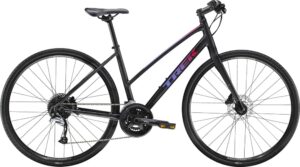
Trek FX 3 Disc Women's Stagger
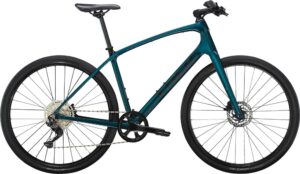
Trek FX Sport 4
More hybrid bikes view all.

Raleigh Redux 2
Get down in the city with the Redux 2! Ready to commute, hit the pub, or ride home from a show, the Redux 2 is up for the challenges of…
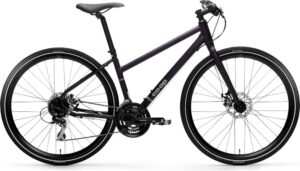
Co-op CTY 1.1
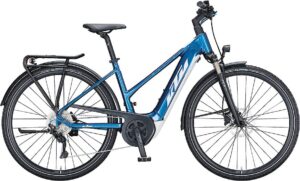
KTM MACINA SPORT P510
Deals view all, view all deals, recent posts view all.

What is Road Bike Database?
Whether you're a seasoned cyclist or just starting out, choosing the right road bike can…
Send Feedback
Have a suggestion? Looking for a bike that's not on Road Bike Database? Or perhaps you've spotted an error?
We'd love to hear from you. Let us know with the form below.
This website uses cookies to ensure you get the best experience possible. Learn more.
About Road Bike Database
Explore, search and compare thousands of the world’s best road bikes here on Road Bike Database.
Compare prices, components, reviews, images and more on current and past road bikes. You can even share reviews, comments and questions on road bikes. View and compare a huge selection of bikes from brands such as Cervélo , BMC , Trek , Specialized and more .
We strive to provide accurate and up-to-date information for road bikes on Road Bike Database. If you’ve spotted any issues, please let us know . We also include helpful tools, such as our frame size calculator, to assist you in choosing the right road bike. Bear in mind that these tools serve as a guide and simply provide a general indication. Refer to information provided by your bike manufacturer for the most applicable information for your bike.
Bikes By Brand
Bikes by year, bikes by riding style.
- Electric Road
- folding-bike
- general-road
- general-urban
- long-tail-cargo
Bikes By Wheel Size
Popular bikes.
- 2023 Riese & Müller Load4 75 vario
- 2022 Liv Avail, Advanced 1
- 2022 Bergamont E-Horizon Premium SUV Amsterdam
- 2021 VAN RYSEL Road Bike Ultra CF Potenza
- 2022 Riese & Müller Transporter2 65 vario
- 2023 Megamo PULSE ELITE AXS 07
- 2021 Wilier Cento10NDR SHIMANO ULTEGRA R8020
Latest Bikes
- 2024 Riese & Müller Delite4 GT touring
- 2024 Riese & Müller Delite4 GT rohloff
- 2024 Riese & Müller Delite4 GT rohloff HS
- 2024 Riese & Müller Delite4 GT vario HS
- 2024 Riese & Müller Delite4 GT vario
- 2024 Riese & Müller Delite4 GT touring HS
- 2024 Riese & Müller Roadster4 Mixte vario HS
Trek FX 2 Disc Equipped review: Unspectacular but effective
The trek fx 2 disc is a versatile all-rounder with surprising levels of comfort and stability.

Cyclingnews Verdict
Built around a frame with a superb balance between responsiveness and comfort, the Trek FX 2 Disc Equipped will tackle any task required of a hybrid bike in an effective, if unspectacular, manner
The frame has a great balance between responsiveness and comfort
Equipped for night riding, bikepacking or commuting
Can carry a decent amount of weight
Stable ride for long distances
Would need a drivetrain upgrade to become a serious fitness bike
On the heavy side for a rigid frame
You can trust Cyclingnews Our experts spend countless hours testing cycling tech and will always share honest, unbiased advice to help you choose. Find out more about how we test.
A hybrid bike can and will mean different things to different people. But sometimes it is simply the bike that fills the gaps, that doesn't do any one thing but in fact does it all. Purists may scoff and say to compromise is to ruin the essence of life: if you are not something, you are nothing. But Trek has offered a repost: if you can't be something, be everything.
That certainly appears to be the aim of the Trek FX 2 Disc Equipped. It's the jack-of-all-trades, odd-jobber of a bike. It comes, as the name suggests, fully loaded with a pannier rack, lights, mudguards and even a kickstand but what elevates it to a place among the best budget hybrid bikes available today is that, as part of Trek's fitness range, all that versatility does not come at the cost of all rideability.
And that's a crucial element. Just because a bike has more practical functions – going to the shops, commuting, family bike rides etc – doesn't mean it can't be fun, have its own personality and leave us looking forward to running that next errand.
Trek's FX range of bikes is quite extensive, starting at the £500.00/$599.99 FX 1 and going all the way to the full-carbon £3,050.00/$2,799.99 FX Sport 6. The FX 2 is available with a step-through frame – in both the Equipped and standard versions – and has been updated for 2023, with the main difference from the 2021 model being a move from a 3x8 to a 2x9 gearing system.
The FX 2 Disc Equipped is priced at £740.00 - it's not currently available in the USA - which is £90 more than the FX 2 Disc standard (£650.00/$799.99) which foregoes the rack, lights, mudguards and kickstand. Although it does come in a couple of extra colour options.
Design and specification
Recognising alloy frames' bad reputation for comfort compared to steel and carbon, Trek set itself a goal to "build more compliant frames that retain the acceleration and affordability that have always made aluminium popular" – and it is the fruit of that labour that the FX 2 Disc Equipped is designed around.
The Alpha Gold Aluminium frame, while not the lightest, does offer a great balance between responsiveness and comfort. It is also strong: according to Trek, the FX 2 Disc can take weights of up to 136kg (for bike, rider, and cargo combined), which fares well compared to other hybrid bikes in the same class such as the Merida Speeder 200 (120kg) and Scott Sub Cross 50 (128kg). The pannier rack that comes with it is also very solid and suitable for carrying loads up to 25kg despite weighing less than 600g itself.
My size large test bike as a whole weighed in at 13.4kg with pedals. The rack, lights, mudguards, and kickstand account for just over a kilogram of that weight but it's still a touch on the heavy side for a fixed-frame hybrid in this price range.
While the focus is on the practicality of the frame, it is by no means ugly – especially when stripped of all the accessories – with internal cable routing, a gentle curve to the top tube that is reminiscent of the Specialized Sirrus (one of the classic beauties of the hybrid world) and the choice of a striking Viper Red or classy Lithium grey colourway. The geometry is pretty much what you would expect from a hybrid, with perhaps a slightly longer chainstay length adding to its stability. It is not as upright as, say, the Sirrus but similar to the Cannondale Quick 3 – which is a good bike to use as a comparison in general.
Like the Quick 3, the Trek FX 2 comes with a Shimano Acera/Altus 2x9 drivetrain and has an integrated mounting system in the stem, as well as the ability to track cadence and other metrics using an integrated wireless sensor.
Trek's Blendr stem system is designed for easy installation of computers, lights and other accessories to your cockpit. It does, rather annoyingly, require an additional base to be purchased (which plugs into the stem) and then a further mount for the specific accessory (which attaches to the base) but that does allow for a wide range of options to suit all needs.
The DuoTrap S is a Bluetooth/ANT+ sensor that integrates into the chainstay and wirelessly transmits to a smartphone or computer to track cadence and other metrics. Again, it requires a separate purchase, but the frame is set up for it to be attached without the need for zip wires or other ungainly fasteners.
Trek has made an effort to include ergonomic grips on the FX 2 Disc Equipped, although they are a little on the basic side, especially compared to those on the more expensive models in the FX range.
The lights, however, are far more impressive, particularly the AXA Greenline 35 headlight. USB-charging, it has a wide beam, is also designed to be visible from the side and is discreetly mounted on the top of the fork, which avoids cluttering the cockpit.
The Tektro HD-R280 hydraulic disc brakes are pretty standard now for mid-range hybrids. My test bike came with Bontrager H2 Comp 700x32c tyres but with the mudguards fitted there is room for up to 35mm and Bontrager H2 Hard-Case Light 700x35c tyres are listed as an option on the spec sheet. Without the mudguards, Trek says the frame can accommodate tyres up to 38mm in width.

Performance
Trek deserves credit here for really delivering on its aim of a responsive-yet-compliant frame. It's one thing coming up with the jargon, but another bringing it to fruition at a genuinely affordable price. While the FX 2 Disc Equipped might come across as a bit of a plodder on paper, in reality, it has a surprising amount of responsiveness. Loaded up with a carry pack on top of the pannier rack, I was happy overtaking other cyclists on reasonably fast country roads, knowing I had the acceleration to get past and back across to the side of the road in ample time.
Yes, it's no speed demon – it doesn't have the playfulness of the Boardman URB 8.9 or the lightweight climbing ability of the Merida Speeder 200, two bikes at a similar price point – but where it completely outscores both is in comfort and stability, even with a rack, mudguards, light, kickstand all bolted on.
Interestingly enough, I took it for a ride with all those added extras stripped off and, while significantly lighter – making an obvious difference on climbs – there was not a huge noticeable change in its performance on the flat.
My test bike came with a slightly-different-to-advertised Microshift Marvo front derailleur instead of Acera T3000, which is roughly equivalent, and I had no issues with it. However, as a whole, I did find the drivetrain to be under-par for a fitness bike. It's perfectly functional and will get you pretty much wherever you need to go, but it is a little clunky and I noted that the next bike up in the FX range, the FX 3 Disc Equipped , comes with a 10-speed Shimano Deore groupset which, in my experience, is a huge step up in performance.
In particular, I could not get to grips with the drastic change when switching chainrings on the 46/30 chainset. If I didn't downshift on the 4th sprocket or earlier I found myself spinning out – and this is perhaps a rare example of the FX 2 Disc Equipped coming a little unstuck wanting to satisfy in all areas. That 16-tooth difference in the chainrings (the same difference as a 50/34 compact road chainset, for example) means the bike has the range to get up steep hills while also having enough gas on the flats, but the user experience is compromised a little in doing so.
Where it doesn't compromise, however, is in its comfort and handling, whether I took it on potholed roads, bike paths, or light gravel it felt so balanced and stable. I was even happy taking it on the grassy, rutted track of a nearby nature reserve – and this was all with the standard 32 mm tyres it came with. Even when there was a little rattling, you could tell it was coming from the rack, fenders, and lights rather than the frame.
Taking it out at night in light rain did little to change my faith in its dependability and the lights were superb, particularly the wide-beam fork-mounted headlamp – a marked improvement from the usual glorified-torch-on-the-handlebars setup I usually use. Neither front nor rear light offered an intermittent option but, having been driven to distraction on long night rides behind blinking bulbs in the past, that was no great loss to me.
I took the Trek FX 2 Disc Equipped on rides around the countryside, trips to the shops, rides with the kids, rides at night, in the rain, for exercise, for errands and more, and on every occasion, it delivered. It is solid and dependable without feeling clunky or cumbersome. It's not sexy but it's not ugly. It's not overly fun but it's no chore to ride.
It will do what it needs to do in almost every situation you will need a hybrid bike for. Not necessarily to the highest level, but to a high enough level that you won't feel like you are missing out.
Yes, I did find the Altus/Acera groupset to be restrictive in terms of performance but drivetrains can be upgraded, along with wheels and grips and seatposts etc. Having a top frame is such a great building block. I would stress, however, this frame still has a ceiling to what it can do as a fitness bike, even if it were upgraded in all those areas. It is built for sturdiness as much as anything else and the fact that its performance was similar with and without the rack, fenders, kickstand et al is quite telling. I'm not going to use it to take on the Brecon Beacons in the Dragon Ride but I might choose it over a more expensive performance-oriented bike for a long-distance overnight ride such as the Dunwich Dynamo , where comfort, stability and safety are the overriding priorities.
Tech specs: Trek FX 2 Disc Equipped
- Price Trek FX2 Disc Equipped : £740.00 / $N/A
- Price Trek FX2 Disc : £650.00 / $799.99
- Sizes : S, M, L, XL
- Weight : 13.4kg (actual, size L, with pedals)
- Frame : Alpha Gold Aluminium
- Fork : FX Alloy
- Shifters : Shimano Altus M2010, 9-speed
- Front derailleur : Microshift Marvo
- Rear derailleur : Shimano Altus M2000
- Crankset : 46/30
- Cassette : Shimano HG200, 11-36, 9-speed
- Brakes : Tektro HD-R280 hydraulic disc
- Wheels : Bontrager Connection
- Tyres : Bontrager H2 Comp, 700x32c
- Saddle : Bontrager Sport
- Seatpost : Bontrager Alloy, 12mm offset
- Stem : Bontrager Comp, Blendr Compatible, 7-degree, 90mm length
- Handlebars : Bontrager alloy, 31.8mm, 15mm rise
- Extras : Rack, Eurofender Snello mudguards, Spanninga SOLO rear light and AXA Greenline 35 headlight, Bontrager Satellite grips, kickstand

Thank you for reading 5 articles in the past 30 days*
Join now for unlimited access
Enjoy your first month for just £1 / $1 / €1
*Read any 5 articles for free in each 30-day period, this automatically resets
After your trial you will be billed £4.99 $7.99 €5.99 per month, cancel anytime. Or sign up for one year for just £49 $79 €59
Try your first month for just £1 / $1 / €1
Ben has been a sports journalist for 16 years, covering everything from park football to the Olympic Games. As well as cycling, his passions include podcasts, tennis and speaking enough Italian to get by on his snowboarding trips to the Dolomites. A DIY rider who is almost as happy in the toolbox as he is in the saddle, he is still trying to emulate the feelings he experienced as a nine-year-old on his first Peugeot racer – he couldn’t fathom the down-tube friction shifters then and he’s still wrestling with groupsets now. When he isn’t making a beeline for the nearest Chiltern hill, he is probably tinkering or teaching his kids how to clean a bike properly. He rides a heavily modified 1980 Peugeot PVN10 Super Competition (steel is real) when the road is smooth and dry, and a BMC Alpenchallenge when it’s not.
3D-printed titanium to headline Ribble’s new Allroad line
Mid-pack to podium contender in just three months: How I pulled out all the stops for British gravel nationals
Visma-Lease a Bike sports director: Vingegaard has to improve or 'he probably won't be able to beat Pogačar'
Most Popular

- Stores Stores
Two-Minute Pump-Up Inflate your tires before every ride for more fun The easiest way to keep your bicycle running well is checking tire pressure before every ride. Properly inflated tires ride great, last long and resist flats. Plus, keeping the tires pumped prevents wheel damage should you hit a rock or pothole while riding. Bent wheels hinder braking and cost a pretty penny to repair. Fortunately, checking tire inflation is simple once you have the only tool required: a bicycle tire pump (don't use your local gas station pressure hose because it can overinflate and damage tires). Bike shops sell quality pumps (about $30 to $60) that are easy to use and safe. You might also have a battery-powered inflator for your car that will work if it reaches sufficient pressures. It's best if your pump fits both bicycle valves (Schrader and Presta; the shop will understand) and sports a built-in gauge, which makes it easy to get the pressure right. Pressure Check How do you know how much air to put in your tires? On most tires, the recommended pressure is printed on the sidewall. It's often written as a range, such as "90 to 115 psi (pounds per square inch)," which appears on some high-pressure road tires. You can experiment within this range to find what feels best for you. Less pressure offers a more comfortable ride and more air means less rolling resistance. Many cyclists opt for the best of both worlds and run 100 to 105 psi in their skinny road tires. Find the proper tire pressure range on your tire’s sidewall. If you're inflating 26-inch tires (common on comfort and off-road bikes), you may find that the pressure range is wider, say "35 to 60 psi." This is because these tires can be used on and off road. For the former, 60 psi is about right because it rolls optimally on pavement. Off road, however, 35 to 40 psi is much more appropriate because it absorbs the bumps, rocks and roots better and offers greater traction for control and handling. Air Time Inflating a tire is as simple as attaching the pump head to the valve and pumping. You'll need to unscrew and remove the valve caps first if your tubes have them. And, if you have Presta valves (they have a knurled tip and are also called "French" valves), you'll need to open the valve by unscrewing and depressing the tip just long enough to let a tiny amount of air out (remember to close it after pumping, too). Then, attach the pump and start stroking, stopping when the gauge shows that you've reached the recommended pressure. Repeat with the other tire. And you thought bicycling only exercised your legs!

- Visit Our Blog about Russia to know more about Russian sights, history
- Check out our Russian cities and regions guides
- Follow us on Twitter and Facebook to better understand Russia
- Info about getting Russian visa , the main airports , how to rent an apartment
- Our Expert answers your questions about Russia, some tips about sending flowers

Russian regions
- Chelyabinsk oblast
- Khanty-Mansi okrug
- Nefteyugansk
- Nizhnevartovsk
- Kurgan oblast
- Sverdlovsk oblast
- Tyumen oblast
- Yamalo-Nenets okrug
- Map of Russia
- All cities and regions
- Blog about Russia
- News from Russia
- How to get a visa
- Flights to Russia
- Russian hotels
- Renting apartments
- Russian currency
- FIFA World Cup 2018
- Submit an article
- Flowers to Russia
- Ask our Expert
Khanty-Mansi Autonomous Okrug - Yugra, Russia
The capital city of Khanty-Mansi okrug: Khanty-Mansiysk .
Khanty-Mansi Autonomous Okrug - Yugra - Overview
Khanty-Mansi Autonomous Okrug - Yugra is a federal subject of Russia, part of the Urals Federal District. Khanty-Mansiysk is the capital city of the region.
The population of Khanty-Mansi Autonomous Okrug - Yugra is about 1,702,200 (2022), the area - 534,801 sq. km.
Khanty-Mansi okrug flag
Khanty-mansi okrug coat of arms.
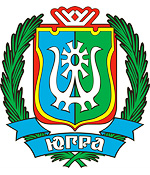
Khanty-Mansi okrug map, Russia
Khanty-mansi okrug latest news and posts from our blog:.
21 March, 2020 / Nizhnevartovsk - the view from above .
8 November, 2017 / Surgut - the view from above .
4 March, 2017 / Khanty-Mansiysk - the view from above .
12 February, 2016 / Khanty-Mansi Autonomous Okrug from above .
21 May, 2013 / The most powerful thermoelectric power station in Russia .
More posts..
History of Khanty-Mansi Autonomous Okrug - Yugra
Yugra is the historical homeland of the Ob-Ugric peoples: Khanty, Mansi, Nenets, and Selkup. They were engaged in hunting, fishing, cattle breeding. After the Turkic peoples pushed them from south to north, these peoples had to apply their skills in more severe conditions. It is at this new location Ugrians began to domesticate deer.
In the first half of the second millennium AD, the main features of the material and spiritual culture of Khanty, Mansi and forest Nenets were formed. It is believed that since then they have not undergone major changes. Since the second half of the 13th century, a new factor in the development of the region was its entry into the Golden Horde.
At the end of the 14th century, the collapse of the Golden Horde led to the emergence of a separate Tyumen Khanate. In 1495, the Siberian Khanate appeared. At that time the basic principles of political, administrative and socio-economic organization of this territory were developed. The region was called Ugra or Yugra.
More historical facts…
The region became part of Russia in the end of the 16th century. From the middle of the 18th century, this region became a place of exile for criminals. December 10, 1930, Ostyako-Vogul national okrug was formed with the center in the settlement of Samarovo. Construction of a new center began 5 km away from it. In February 1932, the new center of the region was named Ostyako-Vogulsk.
In 1934, the first steps to find oil and natural gas in the region were taken. October 23, 1940, Ostyko-Vogul national okrug was renamed Khanty-Mansi national okrug and Ostyko-Vogulsk was renamed Khanty-Mansiysk. August 14, 1944, the region became part of Tyumen Oblast. On January 27, 1950, Khanty-Mansiysk became a city.
On September 21, 1953, in Berezovo, the first natural gas in Western Siberia was produced. On June 23, 1960, the first oil in Western Siberia was discovered near Shaim. This was followed by the discovery of many other oil and natural gas fields. Along with the industrial exploitation of oil and gas fields, the timber industry developed rapidly.
By the end of the 20th century, under the influence of demographic and socio-economic developments the Khanty-Mansi region in fact lost its national basis. On July 25, 2003, Khanty-Mansi Autonomous Okrug was renamed Khanty-Mansi Autonomous Okrug - Yugra.
Khanty-Mansi Autonomous Okrug - Yugra views
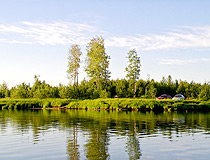
Rest on the lake in Yugra
Author: O.Frolov
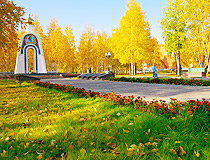
Golden autumn in the Khanty-Mansy region
Author: Leonid Karpushin
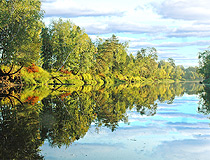
Beautiful nature of Yugra
Khanty-Mansi Autonomous Okrug - Yugra - Features
The name of the region is associated with the self-names of the two main groups of northern peoples - Khanty and Mansi. In the Middle Ages, the word “Yugra” was used to refer to peoples and lands beyond the Northern Urals.
This region, located in the middle of Russia, occupies the central part of the West Siberian Plain. Its territory stretches from west to east for almost 1,400 km, from north to south for 900 km. The area of the region is comparable to France or Ukraine.
The climate is temperate continental characterized by rapid change of weather especially in spring and autumn. Winters are long, snowy and cold with frosts below minus 30 degrees Celsius. Summers are short and warm. From the west this region is protected by the Ural mountains, from the north it is open to cold arctic air.
The highest points of the region are Mount Narodnaya (1,895 m) in the Polar Urals and Mount Pedy (1,010 m) in the Northern Urals. Two major rivers flow in Khanty-Mansi autonomous okrug: the Ob (3,650 km) and its tributary the Irtysh (3,580 km). About 30% of the territory is covered by swamps. There are more than 300,000 lakes surrounded by marshes and forests.
The largest cities of Khanty-Mansi Autonomous Okrug - Yugra are Surgut (396,000), Nizhnevartovsk (280,800), Nefteyugansk (128,700), Khanty-Mansiysk (106,000), Kogalym (69,200), Nyagan (58,500). Today, only about 32,000 people are representatives of indigenous peoples: Khanty, Mansi and Nenets. Half of them live in the traditional way.
This region is very rich in oil and natural gas. The largest oil and natural gas fields are Samotlorskoye, Fedorovskoye, Mamontovskoye, Priobskoye. There are also deposits of gold, coal, iron ore, copper, zinc, lead and other mineral resources.
The climate is not favorable for agriculture. Most of the agricultural products and foodstuffs is brought from other Russian regions. Waterways and railways are the main shipping ways. The total length of the pipeline network is 107,000 km.
About 60% of Russian oil is produced in Khanty-Mansi Autonomous Okrug - Yugra. In total, more than 10 billion tons of oil were produced here. The total number of oil and natural gas fields discovered is 475. In the coming decades, the Khanty-Mansi region will remain the main resource base of hydrocarbons in Russia.
Tourism in Khanty-Mansi Autonomous Okrug - Yugra
Yugra has unique natural, cultural and historical resources for the development of recreation and tourism. On the territory of the region there are historical and cultural monuments, as well as modern infrastructure for lovers of cultural, educational, recreational tourism, and outdoor activities. International events (sports competitions, festivals and forums) help to open this place to foreigners as an amazing corner of the globe.
Khanty-Mansi Autonomous Okrug - Yugra has a number of wonderful natural sites worthy of attention: two nature reserves (“Malaya Sosva” and “Yugansky”), four nature parks (“Samarovsky Chugas”, “Siberian ridges”, “Numto”, “Kondinskie lakes”), ten monuments of nature, archeological complexes (“Barsova Mountain”, “Saygatino”, Sherkaly settlement).
Holidays of the northern peoples are also popular among tourists: Reindeer Herder’s Day, Day of indigenous Peoples of the North “Crow day”, Fisherman’s Day, Bear holiday and others.
Active and extreme types of tourism (skiing, snowboarding, kiting) are gaining in popularity. There are seven ski resorts in the region. In summer, travelers can go rafting on mountain rivers of Siberia. Tourists can also go on a special oil tour that includes a visit to the oil-producing companies. They learn about the oil industry and the history of oil exploration in Siberia.
Khanty-Mansi Autonomous Okrug - Yugra is a region of endless charm of the beautiful nature and modern tourist facilities. True lovers of northern landscapes and local cultures will be able to fully enjoy the incomparable scenery and generous hospitality in Ugra.
Khanty-Mansi okrug of Russia photos
Khanty-mansi autonomous okrug scenery.
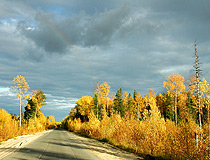
Road through autumn forest in Khanty-Mansi Autonomous Okrug
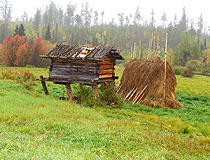
Deep winter snow is not a problem in Khanty-Mansi Autonomous Okrug
Author: Chernenko
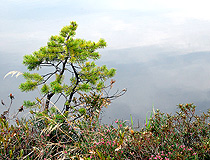
Yugra scenery
Author: Sergej Fedotov
Pictures of Khanty-Mansi Autonomous Okrug - Yugra
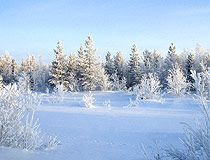
Winter in Khanty-Mansi Autonomous Okrug
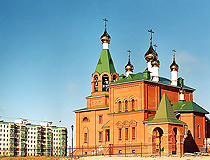
Orthodox church in Khanty-Mansi Autonomous Okrug
Author: Alexey Borodko
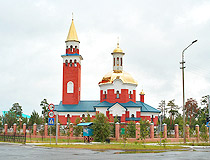
Church in Khanty-Mansi Autonomous Okrug
Author: Peter Sobolev
- Currently 2.80/5
Rating: 2.8 /5 (189 votes cast)

Share ×

Scan the QR code and open PeakVisor on your phone
❤ Wishlist ×
See all region register, peakvisor app, khanty-mansiysk autonomous okrug – ugra.
Welcome to the land of sheer silent whiteness. Its vast expanses are filled with fresh Arctic air, howling winds, and the spirit of true adventure. Come with us to the lands of the ancient Khanty and Mansi tribes that survived in this harsh climate of the Nether-Polar Urals . See the mountains that defy any logical or geological reason for their existence. Experience the wonders of this sparsely populated land where you can hardly see a human trace. Welcome to Yugra!
Flora & Fauna
Water resources, landmarks and tourism, major mountains, mount narodnaya, mount zaschita, mount neroyka, the pyramid mountain, samarovskaya mountain, ski and sports facilities, protected sites, reserves, national and natural parks, rivers and lakes, major cities, khanty-mansiysk.
The Khanty-Mansiysk Autonomous Area – Yugra (KhMAO) is located in the central part of the West Siberian Plain, stretching from west to east from the Ural Range to the Ob-Yenisei Watershed. The vast areas of this plain, as well as the Lower Priob region, are considered one of the most recently inhabited areas.
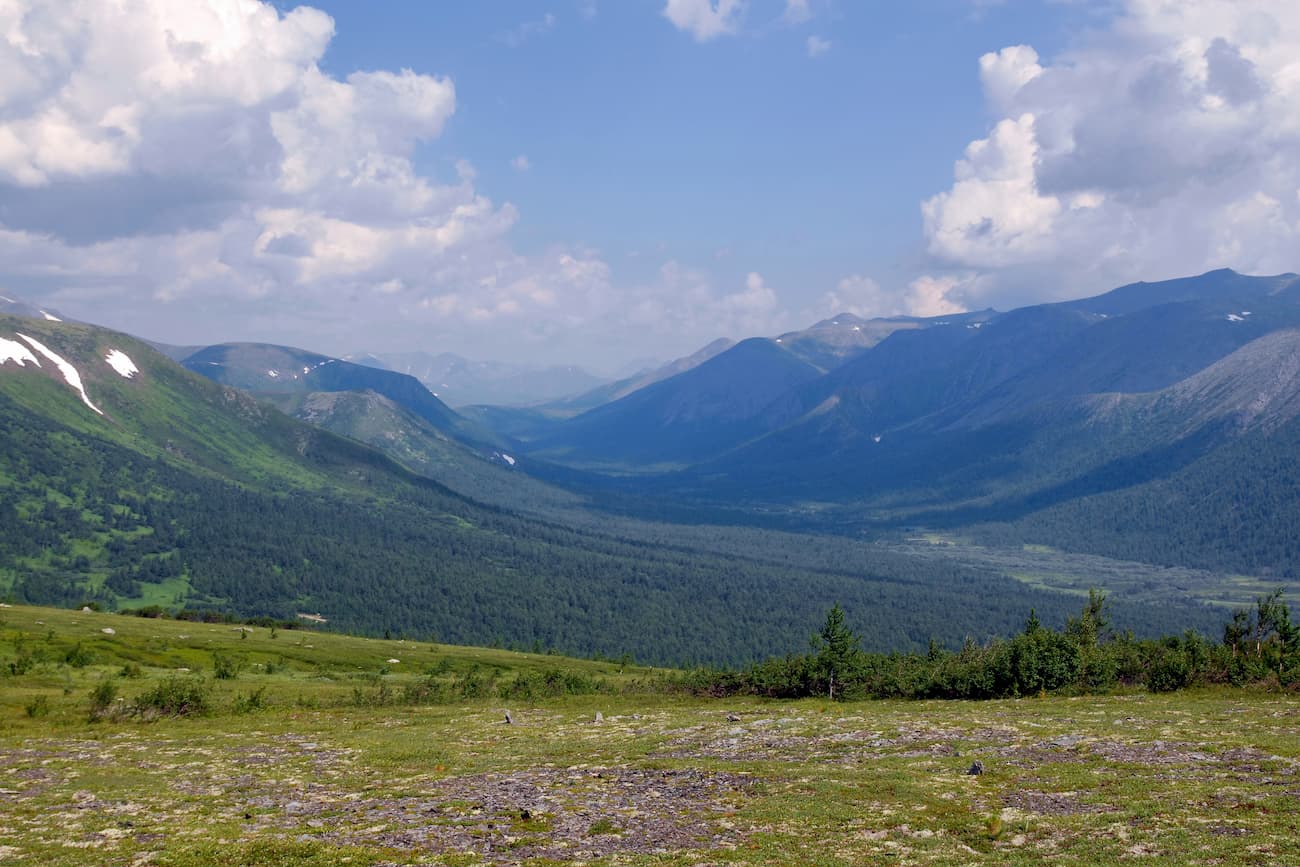
The Khanty-Mansiysk Autonomous Area (KhMAO) was established in 1930. Its name comes from two main northern indigenous peoples – the Khanty and the Mansi. From 1944 it was legally part of the Tyumen Region , but in 1993 the Area received autonomy and became a full-fledged territorial entity of the Russian Federation. It is a part of the Urals Federal District. The administrative centre is the city of Khanty-Mansiysk , whereas the largest city is Surgut. The word Yugra was introduced to the name of the Khanty-Mansiysk Autonomous Area in 2003 to pay tribute to the old name used by the locals to call the territories lying beyond the North Urals.
The KhMAO borders the Komi Republic in the north-west, the Yamalo-Nenets Autonomous District in the north, the Krasnoyarsk Area and the Tomsk Region in the east and south-east, the Tyumen Region in the south and the Sverdlovsk Region in the south-west.
The area of the territory is 534,801 sq.km, the length from north to south is 800 km, from west to east is 1400 km. The population of this huge territory is 1,674,676 people as of 2020, which is the same amount as people living in Barcelona or Munich.
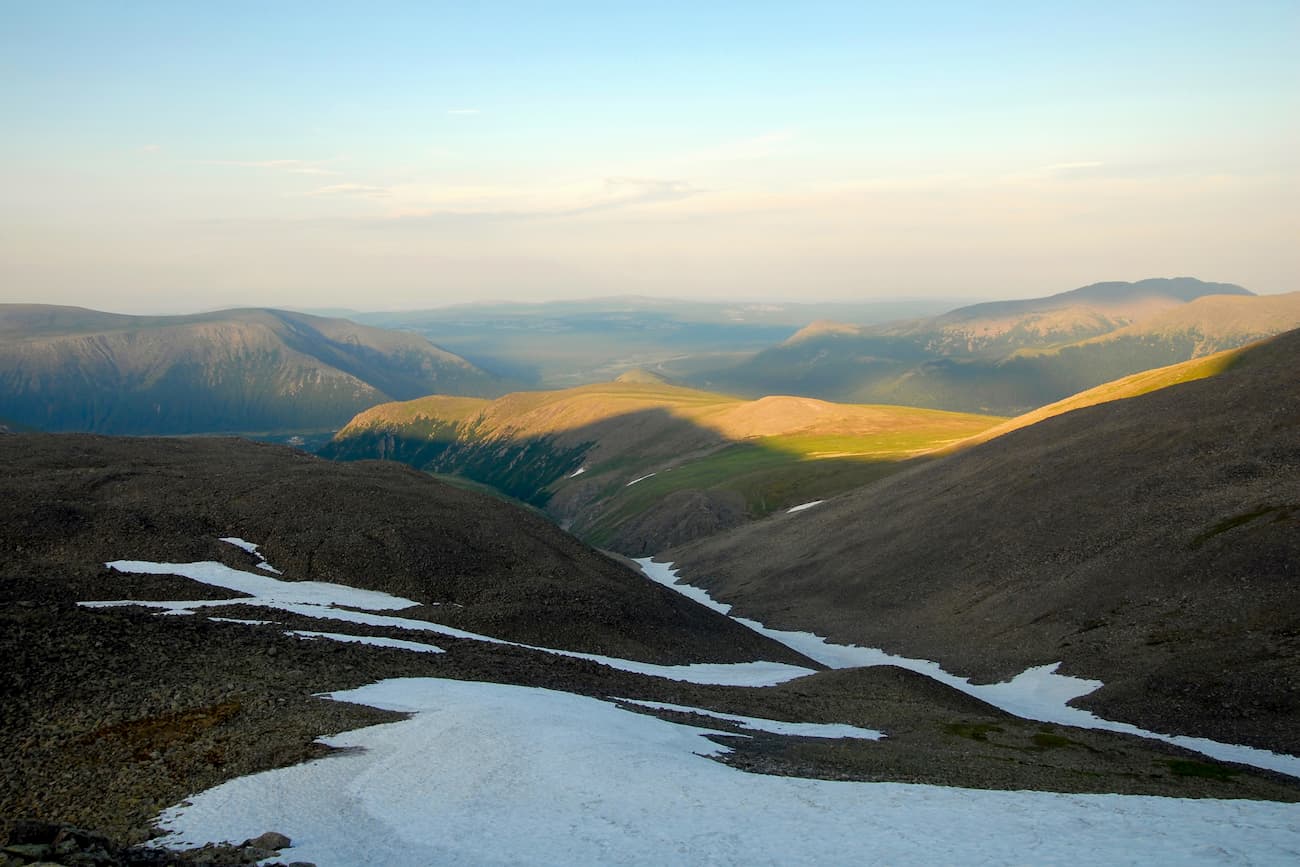
The main part of the territory is a huge, poorly dissected plain where absolute elevation marks rarely exceed 200 meters above sea level. The western part of the KhMAO territory is characterized by low and middle mountainous terrains with some Alpine relief featured in the Subpolar Urals. Here are ridges and spurs of the mountain system of the North Urals and the Subpolar Urals. The maximum absolute elevations are on the border with the Komi Republic . Mount Narodnaya (1,895m) is the highest peak.
More than 800 species of higher plants grow in the Khanty-Mansi Autonomous Area . Almost the entire territory is covered by taiga forests that occupy about 52% of the area. Spruce, fir, pine, cedar, larch, birch, alder grow here. In the northern parts of the area, the composition of the vegetation is greatly influenced by perennial permafrost. Light lichen grasslands which are used as deer pastures are widespread there. Tundra dominates in the mountainous and hilly areas. River floodplains and lowlands are characterized by meadow vegetation, the so-called water meadows. High floodplains of large rivers are mainly covered with woods that mainly feature willows, birches and aspens. Forests and swamps are rich in berries and various valuable plants, most of which are used in traditional indigenous medicine.
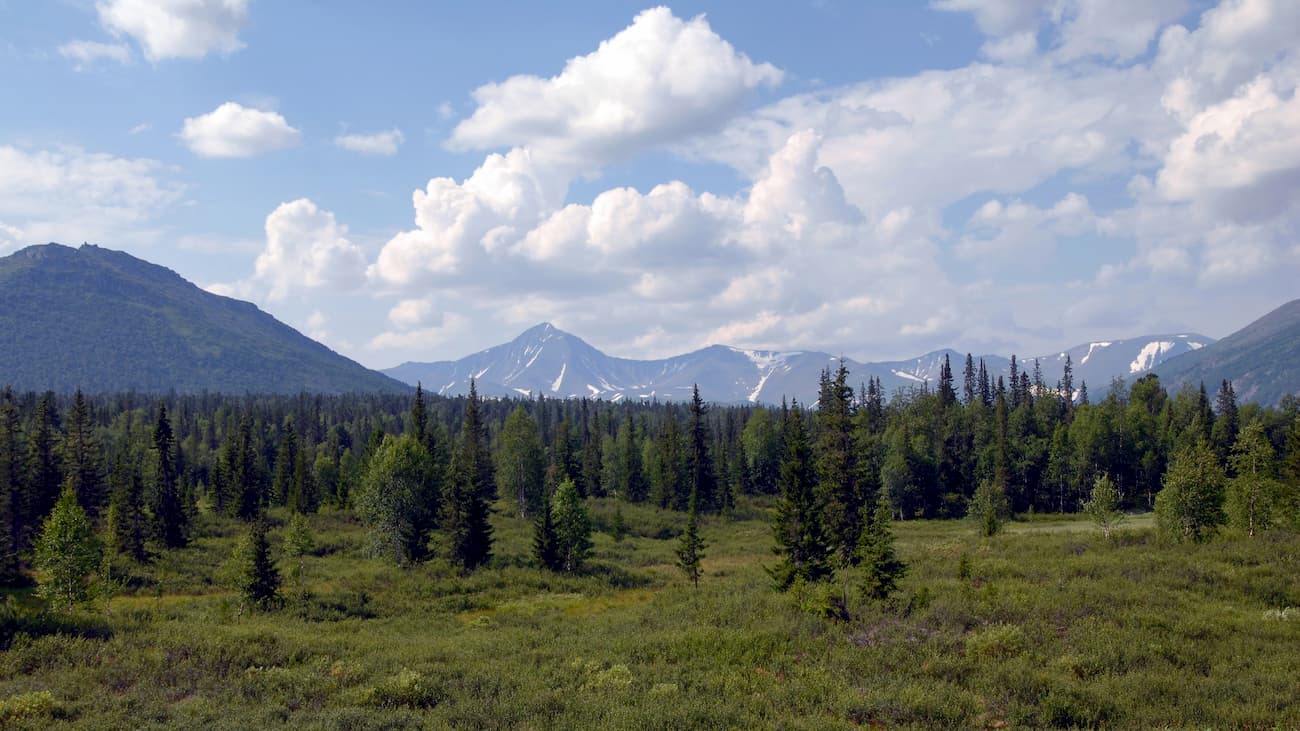
The animal world is typical for the Russian taiga zone. There are 369 species of vertebrates. Mammals are represented by 60 species (28 of them are commercial species). The most common and valuable of them are wild reindeer, elk, fox, sable, fox, squirrel, marten, ermine, Siberian weasel, polecat, mink, weasel, otter, hare and others. Wolverine and West Siberian river beaver are included in the Red Book of Russia.
There are 256 bird species in the region, including 206 sedentary and nesting species. Some rare bird species are listed in the Red Book. There are 42 species of fish in rivers and lakes. Of these, 19 species are commercial, among them are starlet sturgeon, lelema, muksun (whitefish), pelyad, chir, lake herring, wader, tugun, freshwater cod, pike, ide, roach, bream, fir, perch, ruff, golden and silver crucian carp, carp (carp is grown in the cooling ponds of the Surgutskaya and Nizhnevartovskaya hydroelectric plants). Sturgeon is listed in the Red Book. There is an abundance of mosquitoes and gnats in the area, the greatest activity of which is in the second half of summer.
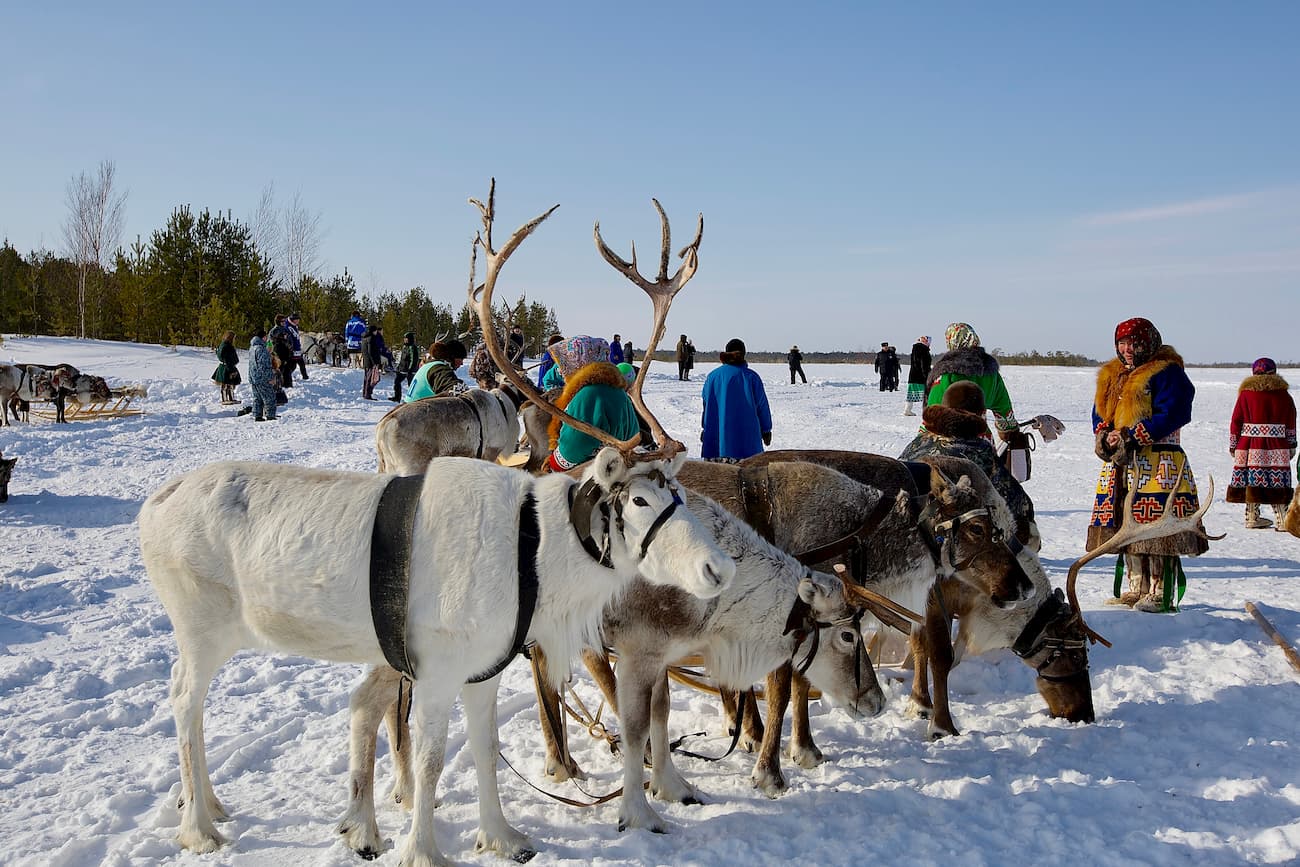
Yugra can boast of over 2 thousand large and small rivers, the total length of which is 172,000 km. The main rivers are the Ob (3,650 km), the Irtysh (3,580 km). These are some of the largest rivers in Russia. Other significant rivers include the tributaries of the Ob (the Vakh, Agan, Tromyogan, Bolshoy Yugan, Lyamin, Pim, Bolshoy Salym, Nazym, Severnaya Sosva, Kazym rivers), the tributary of the Irtysh (the Konda River) and the Sogom River. Ten rivers are over 500 km long. All the Yugra rivers with the exception of the rivers in the Ural part of the region are characterized by rather slow currents, gentle slopes, some surge wave phenomena, spring and summer floods. The Ob River basin extends over a distance of 700-200 km from the mouths of its tributaries. Such abundance of water facilitates the appearance of floodplain swamps and seasonal lakes.
The region's swamps are predominantly of the upper and transitional type. Those water basins occupy about a third of the region. About 290,000 lakes with the area of more than 1 ha are surrounded by swamps and forests. The largest lakes are Tursuntsky Tuman, Levushinsky Tuman, Vandemtor and Trmemtor. The deepest lakes are Kintus (48 m) and Syrky Sor (42 m). However, most of the lakes (about 90%) are modest and quite small and have no surface runoff.
The area is rich in resources of fresh, mineral and thermal underground waters, which are still insignificantly used.
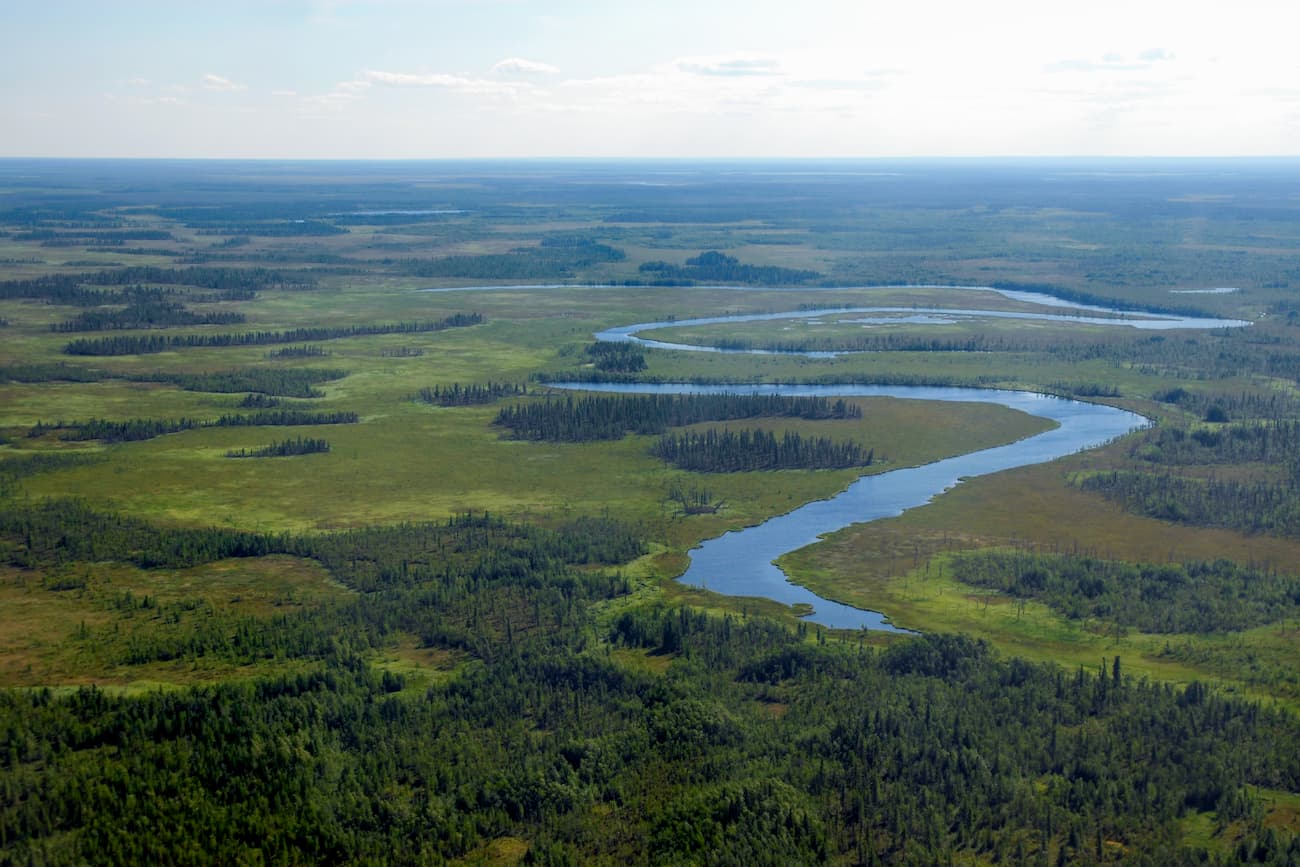
The climate is moderately continental. Winters are harsh, snowy and long, and summers are short and relatively warm. The territory is protected from the west by the Ural Mountains but its openness from the north has a significant impact on the climate formation because cold air masses from the Arctic freely penetrate the area. The flat character of the terrain with a large number of rivers, lakes and swamps also has its impact. Most of the precipitation falls during the warm seasons. But even with a small amount of precipitation, their evaporation is very low, which as a result contributes to the formation of the zone of excessive moisture throughout the Yugra. The snow cover is stable from late October to early May, its height varies from 50 to 80 cm. The region is characterized by a rapid change of weather conditions, especially in transitional seasons (autumn and spring), as well as during the day. Late spring and early autumn frosts are rather frequent and can happen even until mid-June. Average January temperatures range from -18ºC to -24ºC (0 F to -11 F) and can reach -60ºC to -62ºC (-76 F to -80 F) when the northern cold air masses break through. The average temperature in July, the warmest month of the year, ranges from +15ºC to +20ºC (+59 F to +68 F) and on very rare days can reach a maximum temperature of +36ºC (+97 F). The prevailing wind direction is north in summer and south in winter.
The weather in the mountains is quite changeable and cool even in summer. The best time to visit the region's mountains is between July and mid-August.
The Yugra of the Khanty-Mansi Autonomous Area has a huge natural resource potential. These are oil and gas deposits, forests, gold and iron ore deposits, as well as bauxites, copper, zinc, lead, niobium, tantalum, brown and hard coal deposits, rock crystal, quartz and piezo quartz, peat deposits, etc. The region has plenty of natural resources. In terms of natural gas reserves, the Yugra ranks second in the Russian Federation after the Yamalo-Nenets Autonomous District .
The industry is dominated by oil and gas production, power generation and processing industries, including woodworking except for pulp and paper production.
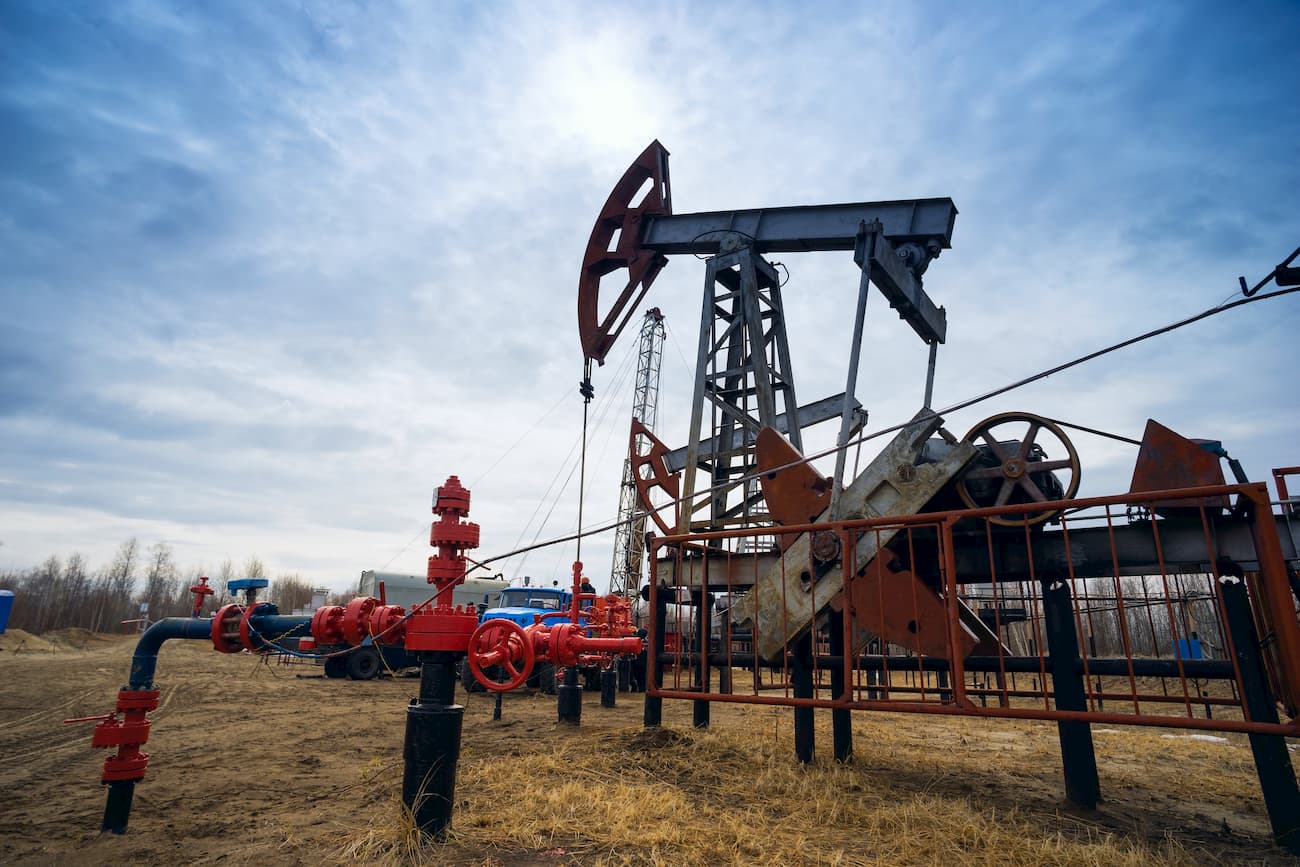
The Khanty-Mansi area has very developed tourism of all kinds. There is a modern infrastructure for cultural exploration as well as for active recreation.
Fans of sports and eco-friendly tourism will be able to conquer majestic mountains and raft down picturesque rivers, enjoy the beauty of nature in nature reserves and natural parks. The hills and mountains of this area open up endless opportunities for skiing and snowboarding.
The mountainous part of the Subpolar Urals located on the territory of the Khanty-Mansi Autonomous Area is very beautiful. The highest peaks of the Ural Mountains are situated here.
Being the highest point of the whole Urals, Mount Narodnaya (1,895 m), also known as Naroda and Poenurr and translated as People's Mountain is territorially situated in the Subpolar Urals, on the border of the Yugra Area and the Komi Republic . It is the highest point in European Russia outside the Caucasus. This leads to its large topographic prominence of 1,772 metres (5,814 ft).
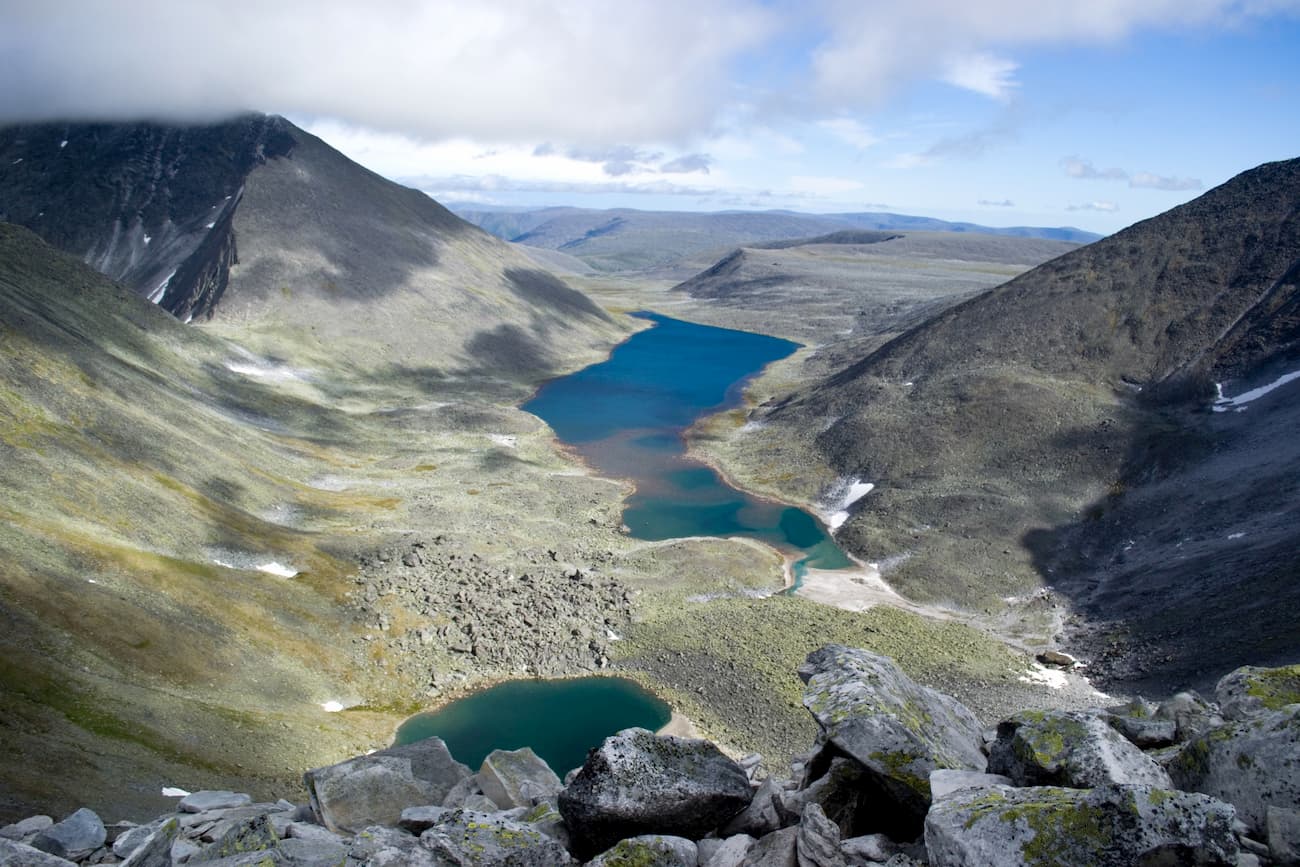
The top of the mountain is half a kilometre from the border towards Yugra. As for the name of the mountain, scientists could not come to a common opinion for a long time, so there are two versions. According to one version, in the Soviet years, an expedition of pioneers gave the mountain a name in honour of the Soviet people - Narodnaya (the stress is on the second syllable). According to the other version, even before the arrival of the first Soviet tourists, the peak was named after the River Naroda (the stress is on the first syllable) flowing at the foot of the mountain. The Nenets peoples called the River Naroda Naro, which means a thicket or a dense forest, and the Mansi peoples called it Poengurr or Poen-urr, which translates as the top, or head. The maps used to refer to it as Mount Naroda or Mount Naroda-Iz. Nowadays, it appears everywhere as Narodnaya.
In the 1980s, someone set a bust of Lenin on the top of the mountain. Its remains can be found there to this day. There is one more symbolic relic there – some Orthodox believers erected a worship cross on top of Mount Narodnaya after a Procession of the Cross.
The slopes of the mountain are steeper in the north-east and south-west and there are many steep rocks on them. The south-eastern and northern parts of the mountain are more gentle but they are also covered with scree. Be vigilant and careful when climbing! On the slopes of the mountain, there are many not only boulders but also caverns filled with clear water as well as ice. There are glaciers and snowfields. From the north-eastern part of the mountain, you can observe Lake Blue near which tourists and travellers like to make bivouacs.
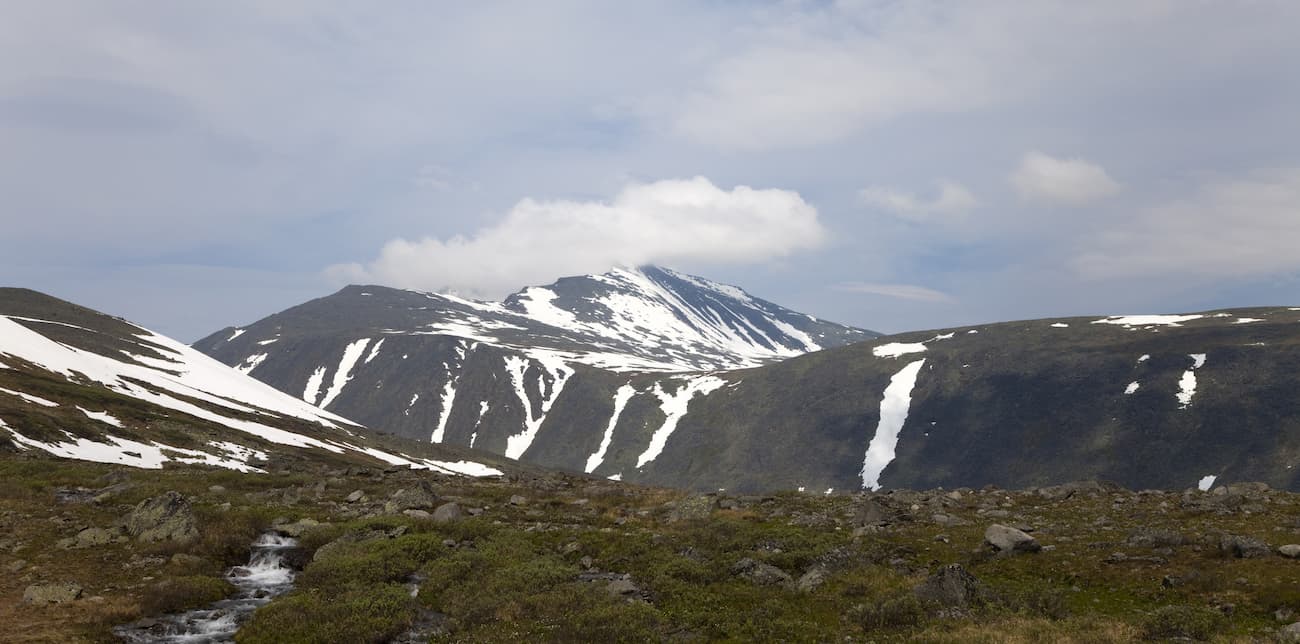
Mesmerizing with its beauty and inaccessibility, it attracts many tourists and fans of active recreation. This majestic mountain is quite remote from the settlements, so getting to it is not an easy task. The mountain is located in the Yugyd Va National Park , so it is necessary to register in advance and get a visit permit from the park administration. How to get to the park administration and get a permit, read the article on the Yugyd Va National Park .
Mountain Zaschita (1,808 m) is the second-highest peak in the Ural Mountains, after Mount Narodnaya . Mysteriously, the name of the mountain, which roughly translates as Defense or Protection Mount, does not correlate in any way with the Mansi names of the nearby mountains and rivers. The origin of the name is unknown. There are some speculations but we will consider just one of them. On the map of the Northern Urals which was made by the Hungarian researcher Reguli the closest peak to Mount Narodnaya was called gnetying olu. Its location coincides with that of the present-day Mount Zaschita . The name gnetying olu in the Mansi can be deciphered as a mountain on which there is some help from ice. The mountain is believed to protect deer grazing on glaciers from mosquitoes. So, early topographers called the mountain more briefly – Mount Defense. Indeed, the slopes of this mountain are covered with a lot of snow and glaciers (the Yugra, Naroda, Kosyu, Hobyu glaciers and others). And it is here that the Mansi shepherds bring their deer which can rest on glaciers and snow. Summarizing all the above, we can say that Zaschita Mount is to some extent protection for deer from mosquitoes. The very name Zaschita appeared on maps with the beginning of hiking tours in the Subpolar Urals.
Mount Neroyka (1,645 m) is 100 km from Neroyka village, the closest tourist base to this peak. In the 1950s, people who were engaged in quartz mining near the mountain worked and lived in this base. Later, a gravel road was built from the village of Saranpaul to the mountain for large-scale development of the quartz deposit. In recent years, the road has not been much used and is practically not cleaned from snow in winter. There has been a plant built 20 km down from the mountain for primary processing of quartz with the use of nanotechnologies. There is an annual big camping event near the mountain. It is organized by the Tourism Department of the Khanty-Mansi Autonomous Area. You can have a 1-hour helicopter ride to the mountain from the village of Saranpaul. Should you wish to fly from the city of Khanty-Mansiysk , be prepared to fly over the taiga for 2.5-3 hours.
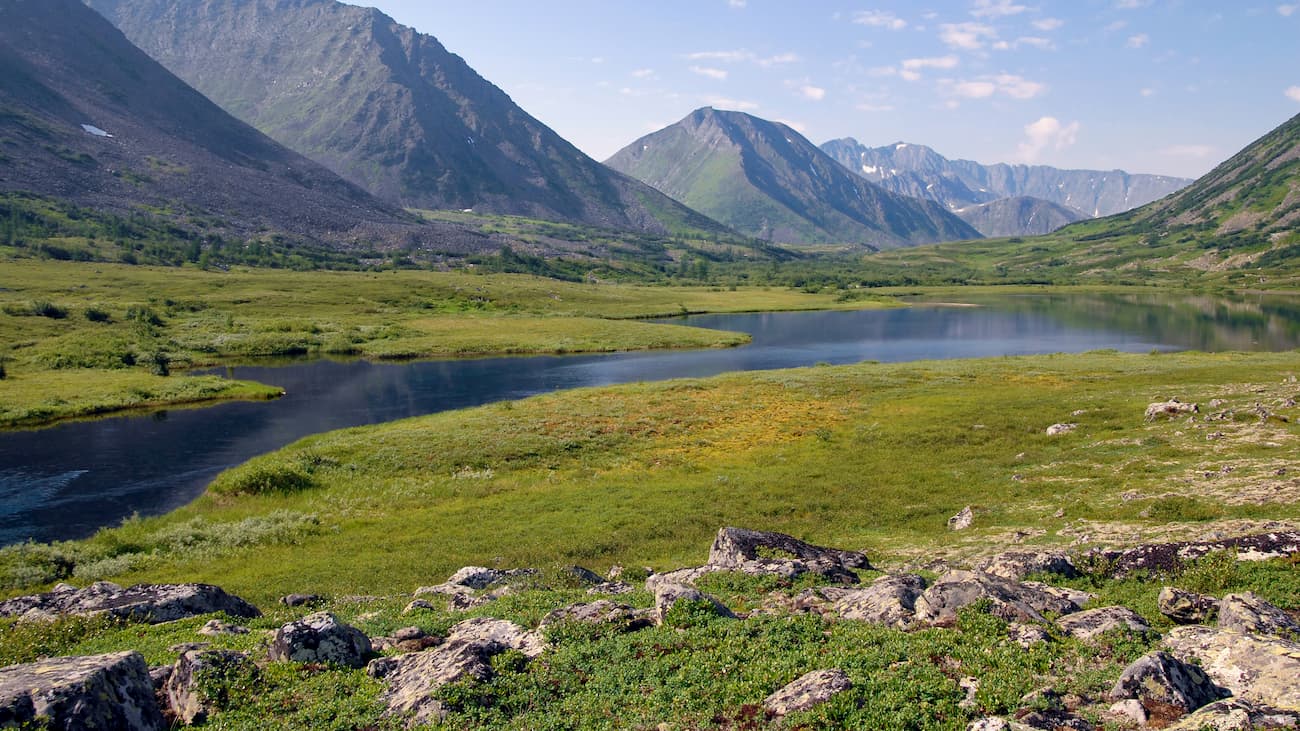
Quite inquisitive tourists happened to discover, by a lucky chance, a Pyramid similar to that of Cheops but four times bigger. It is located on the territory of the Narodo-Ityinsky Ridge. The closest to the pyramid is the village of Saranpaul. The sizes of the found pyramid are as follows: the height is 774 m, in comparison to the Egyptian pyramid which is 147 m; the length of a lateral edge is 230 m whereas the Egyptian pyramid is 1 km. The pyramid is located precisely according to the cardinal directions, there is not a single degree deviation at that. The origin of the pyramid is unknown, scientists are still making assumptions. No traces of human activity were found near the pyramid. The only way to get here at this time is by helicopter.
Samarovskaya Mountain is another wonder that is baffling many people. It is dividing the city of Khanty-Mansiysk into northern and southern parts. Few now living residents know that in the old days the highest part of the modern city used to bear a plural name of the Samarovsky Mountains among which there were Mount Palenina, Komissarskaya, Miroslavskaya, Filinova, and Romanova. Originally, there was a village called Samarovo amidst these mountains. Until now, many issues bewilder both residents and scientists. How could a mountain form in the middle of the West Siberian Plain? What is inside it? Won't the weight of the buildings erected on the top of the mountain affect its height? The uniqueness of Samarovskaya Mountain is that it consists of numerous large stones, boulders, rocks that are absolutely foreign to this area. Scientists have not yet come to a consensus on the mountain’s origin.
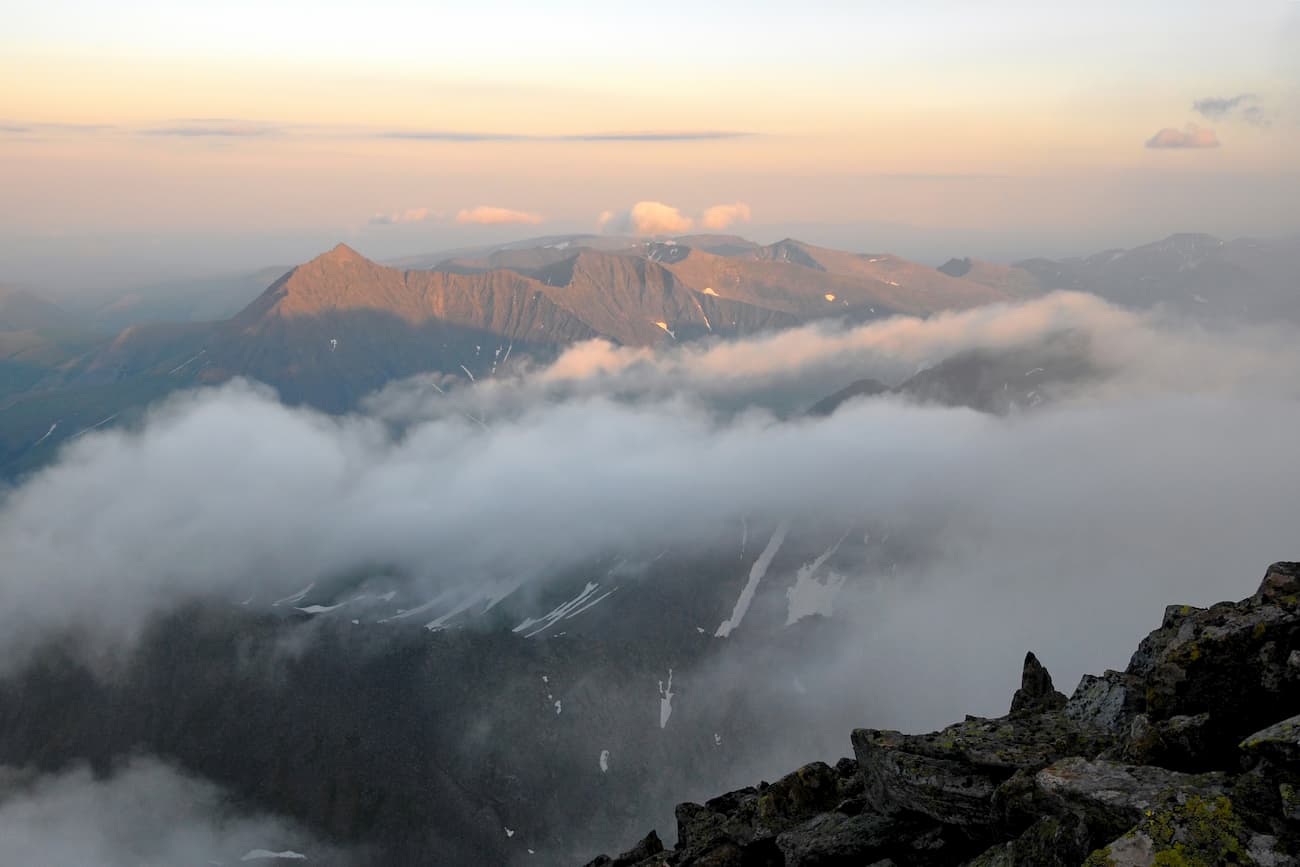
The Yugra is very famous for its ski resorts, the main of which are:
- The Cedar Ravine ski resort (Surgut city, Naberezhny Ave. 39/1)
- Three Mountains (Trekhgorie) ski resort (30 km from Nizhnevartovsk, Ermakovsky settlement)
- Stone Cape (Kamenniy Mys) ski resort (near the city of Surgut)
- Pine Urman ski resort ( Khanty-Mansiysk , Sportivnaya Str., 24)
The far-away lands of the Yugra are the blessed sanctuaries for many animals as the area is rather hostile to a human There are reserves, natural parks, wildlife sanctuaries here that aim to protect the national treasures of the lands. Having visited these regions once, you would crave for coming back again and again to feel that unique sense of unity with nature, to forget about the urban fuss and and hustles whatsoever. The harsh but beautiful nature of this extraordinary area leaves an indelible trace in the soul of every person.
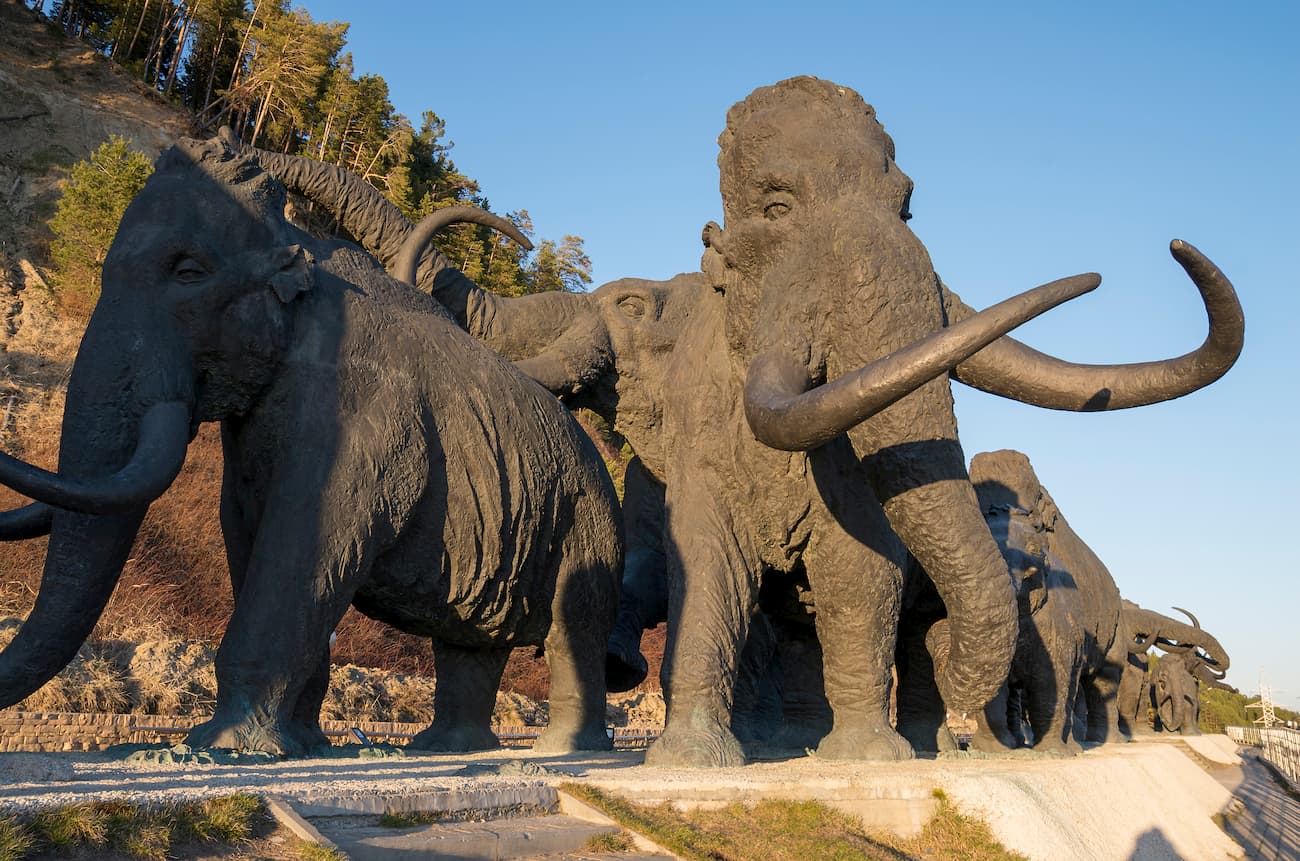
On the territory of the district there are 25 specially protected natural areas, the most famous of them are:
- The reserves are two: the Malaya Sosva Reserve and the Yugan Reserve, the latter was established in 1982 as the largest reserve of taiga landscapes. The purpose of the reserves was to study unobtrusively and carefully preserve the endemic flora and fauna without disturbing natural processes. Hunting and economic activities are prohibited here, which is important for the preservation of natural ecosystems.
- The natural parks are the Samarovsky Chugas Nature Park, the Siberian Sloping Hills (Uvaly), the Numto (also called Lake Numto), and the Kondinskie Lakes.
These reserves and natural parks offer tourists their own excursion programs to make visiting their territory much more enjoyable and educational.
The Samarovsky Chugas Nature Park is located in the center of Khanty-Mansiysk , on a small hill between the Ob and Irtysh rivers.
The territory of the Siberian Sloping Hills (Uvaly) natural park is 350 km away from the city of Khanty-Mansiysk . You can get there by helicopter or by plane. The office of the park is located at 7a Pionerskaya Street, Nizhnevartovsk.
The Kondinskie Lakes Natural Park is located 380 km from Khanty-Mansiysk . Half of the park is covered with swamps, but there is also a recreational area. There you can rest, swim, do some amateur fishing, picking berries (cowberries, cranberries) and mushrooms is permitted. There is only one independent walking route here, it runs for 3 km in the deep forest. It is a cool place for kids since the park is equipped with sports grounds, a pool and a small zoo where the kids can interact with brown bear cubs. What else, try the TaiPark, it is a rope course running at the height of 2.5 meters, having 15 stages, the full length is 125 meters. There is an opportunity to order water walking tours in the town of Sovetsky, which can be reached by train from Khanty-Mansiysk .
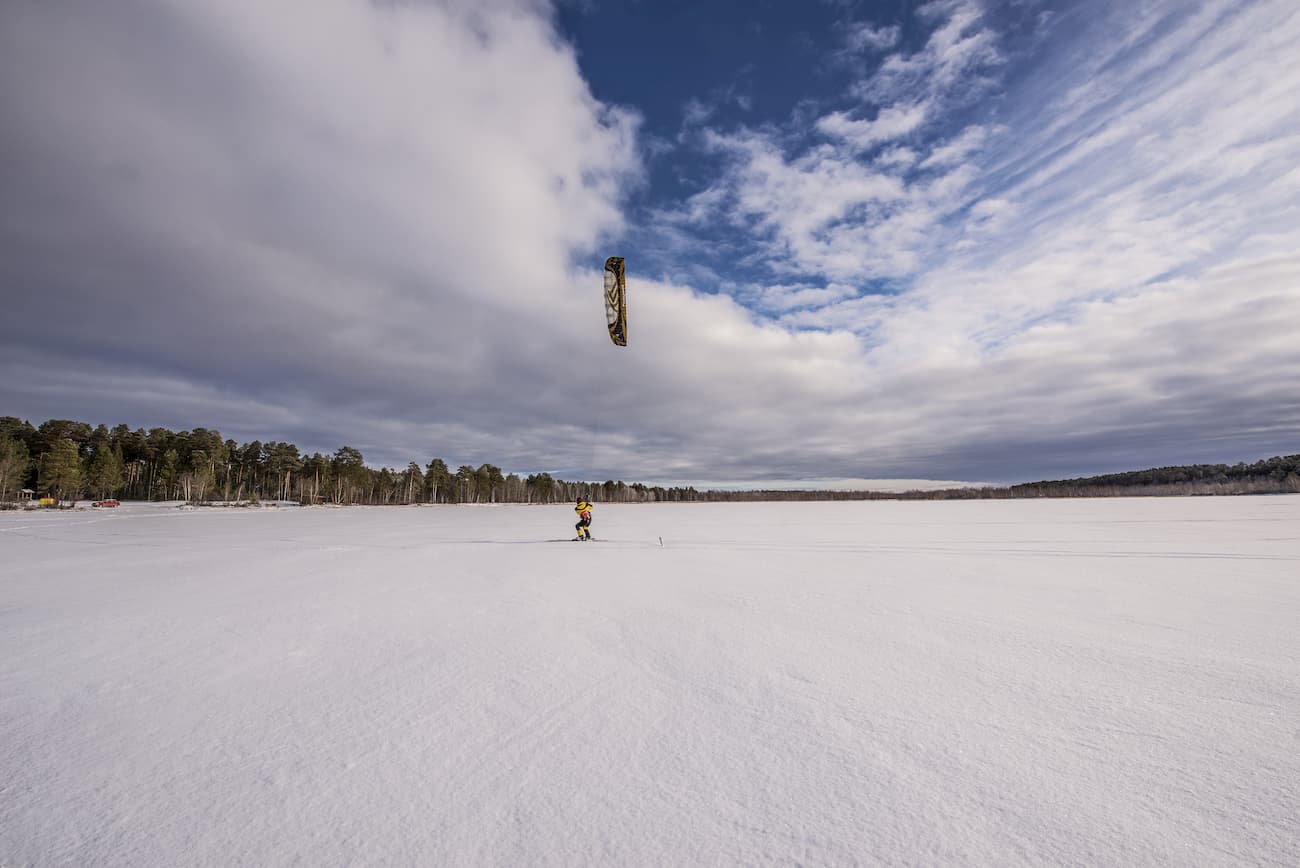
The Numto Nature Park is located almost in the center of the West Siberian Plain, in the Beloyarsk district of the Khanty-Mansi Autonomous Area, 300 km from the city of Surgut and 200 km from the town of Beloyarsk. It is located on the border of Yugra and Yamalo-Nenets Autonomous Area. The administration of the park is located at 2, Beloyarsky micro-district, 4a. The territory of the natural park is a treasure trove of archaeological and ethnocultural monuments. As of today, there have been discovered 20 architectural monuments, including fortified and not fortified settlements, places of worship abandoned by the peoples who lived here from the Stone Age to almost the present day. Researchers have also found 65 monuments of ethnic value, the main of which are worship objects, sacred places and cemeteries.
The Malaya Sosva Reserve includes several subordinated territories and sanctuaries, including Lake Ranghe-Tour. The reserve offers a 4-km walking guided route that gets the visitors introduced to the typical features and characteristics of flora and fauna of the region. The route is called Bear Trail and you can spot bears there (don’t come close though, we’ve already written how to behave if you meet a bear in the wild). Also, you will see the River Malaya Sosva, some marshes, ancient cultural monuments and other nice sights. Permission to visit the reserve can be obtained from the administration of the reserve at Lenina Str. 46, town Sovetskiy.
As to the Yugan Nature Reserve , it is inaccessible to common hikers who are afraid of flying since there are no roads to it. The only way to get there is taking a helicopter ride. You also must obtain a permit in the administration of the reserve, go accompanied by employees of the reserve, and only on special transport of the reserve (motorboat, snowmobile). The central manor of the Reserve and the administration are located in the village of Ugut. To get to this village, you should first go to the town of Surgut, then go to the town of Pyt-Yakh, and from it there is a road to the village of Ugut. It is about 100 km from Ugut to the southern border of the reserve i, and another 25 km to the nearest cordon. The administration works from Monday to Friday. You can request a permit via mail at [email protected] , order a guided tour at [email protected]
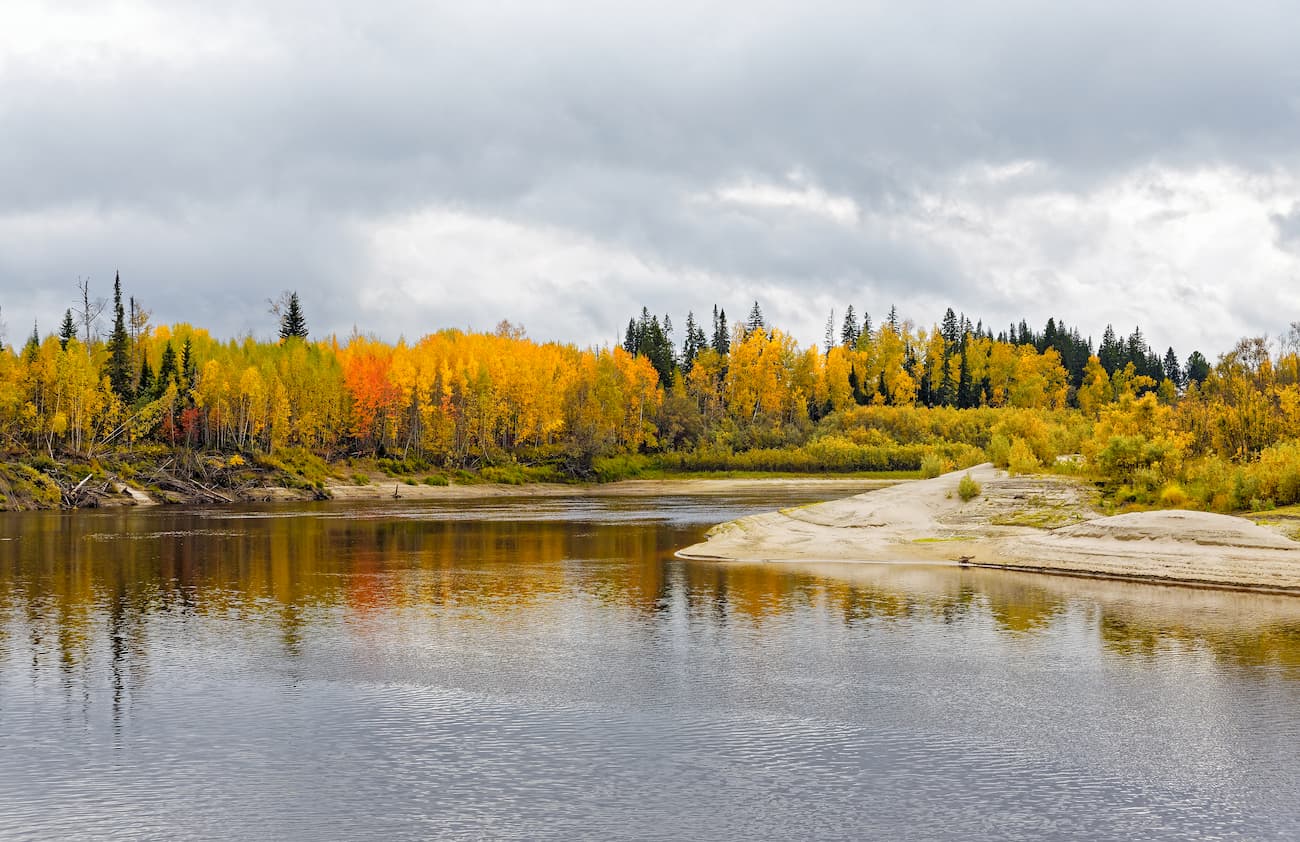
The Yugra lands are heaven for water sports aficionados. They can have some awesome fishing or go rafting along such rivers as: the river Naroda, the Deep Sabun, etc.
The Naroda River is 140 km long. It is the left tributary of the Manya River located in the Ob River basin. The river has its origin on the south-western slope of Mount Narodnaya . It is a mountain-taiga river with rapids, swifts, numerous rolls, which attracts interest among water tourists. However, it is usually not rafted very often.
The Deep Sabun River flows through the territory of the Siberian Sloping Hills Nature Park. The park has developed multi-day water routes. It is possible to raft along the river in summer and to go skiing along it in winter.
The Kondinskie Lakes are a system of lakes along the left bank of the Konda River. The largest lake is the Arantur, with pine forests on the northern side and sandy beaches well equipped for a nice relaxing me-time. The water heats up well in summer. The small river Okunevaya and the river Maly Akh flow into the lake. The Maly Akh comes in on the west side and connects lake Arantur with Lake Pon-Tour. This lake is the richest in fish, and there is also a parking lot for fishermen here. The streams connect Pon-Tour with small lakes Krugloe and Lopukhovoye. When you look at Lopukhovoe lake, you feel as if you have found yourself in a fabulous place: more than half of its surface is covered with white lilies, as well as yellow flowers of the water-beans. Then the river Big Akh, which flows into the river Konda, connects all the lakes into a single system. Along the river there are many archeological monuments such as forts and settlements which have paths to them. The southernmost lake of the park is Ranghe-Tour.
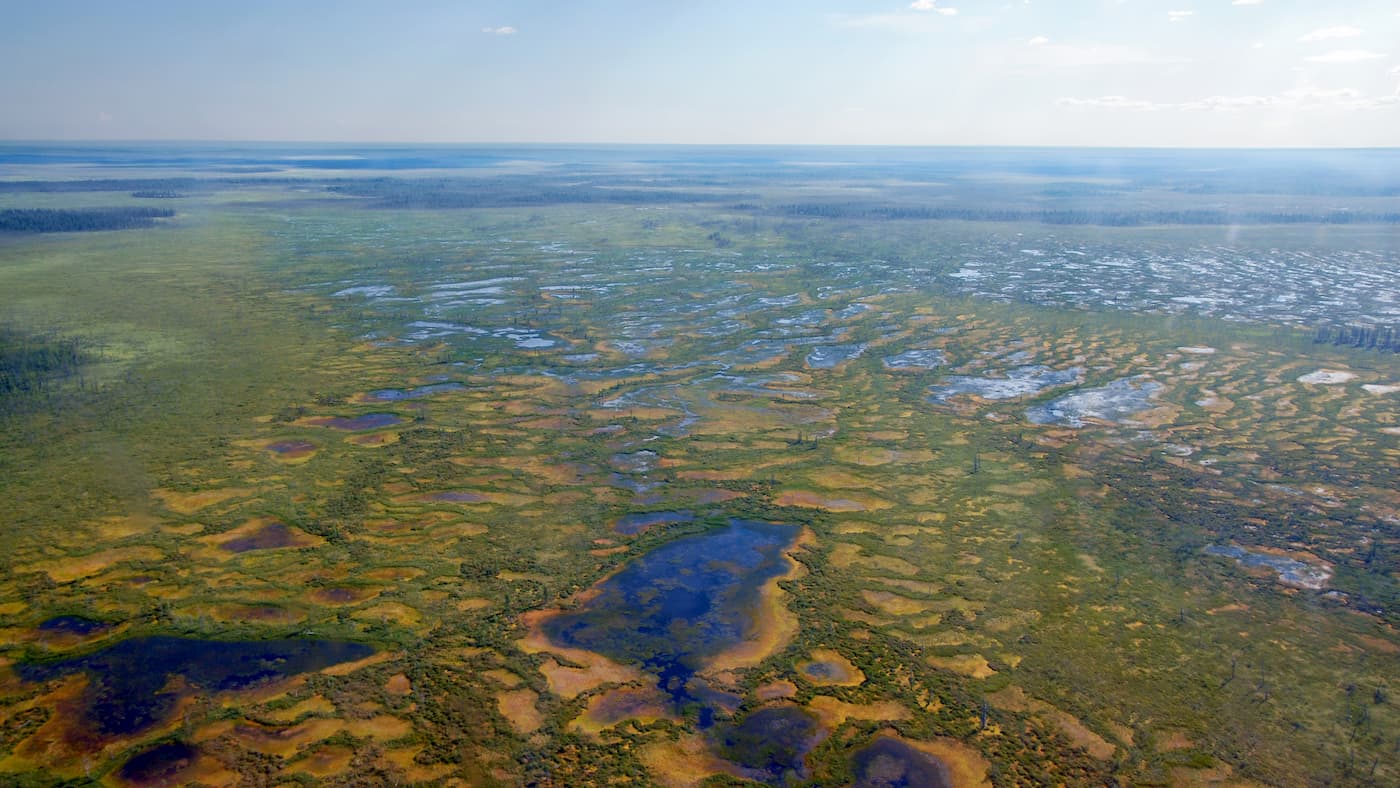
Yugra is not the easiest destination and not the most accessible, but the effort is well worth it. You should first get to the capital of Khanty-Mansiysk Autonomous Area – the city of Khanty-Mansiysk either by air or by train.
Khanty-Mansiysk is based on the premises of the former village Samarovo founded in 1582. It used to be the territory of the Khanty people and a pit stop for coachmen who rode their wagons across the country. The village was founded by Russian Count Samara, thus the name Samarovo. The modern city actually began to develop in 1930 because amidst the Siberian taiga there finally started to appear stone houses on the high bank of the Irtysh River. In 1940, the village was renamed into Khanty-Mansiysk by the name of the peoples living on this territory – the Khanty and the Mansi, and in 1950 it received the status of a town.
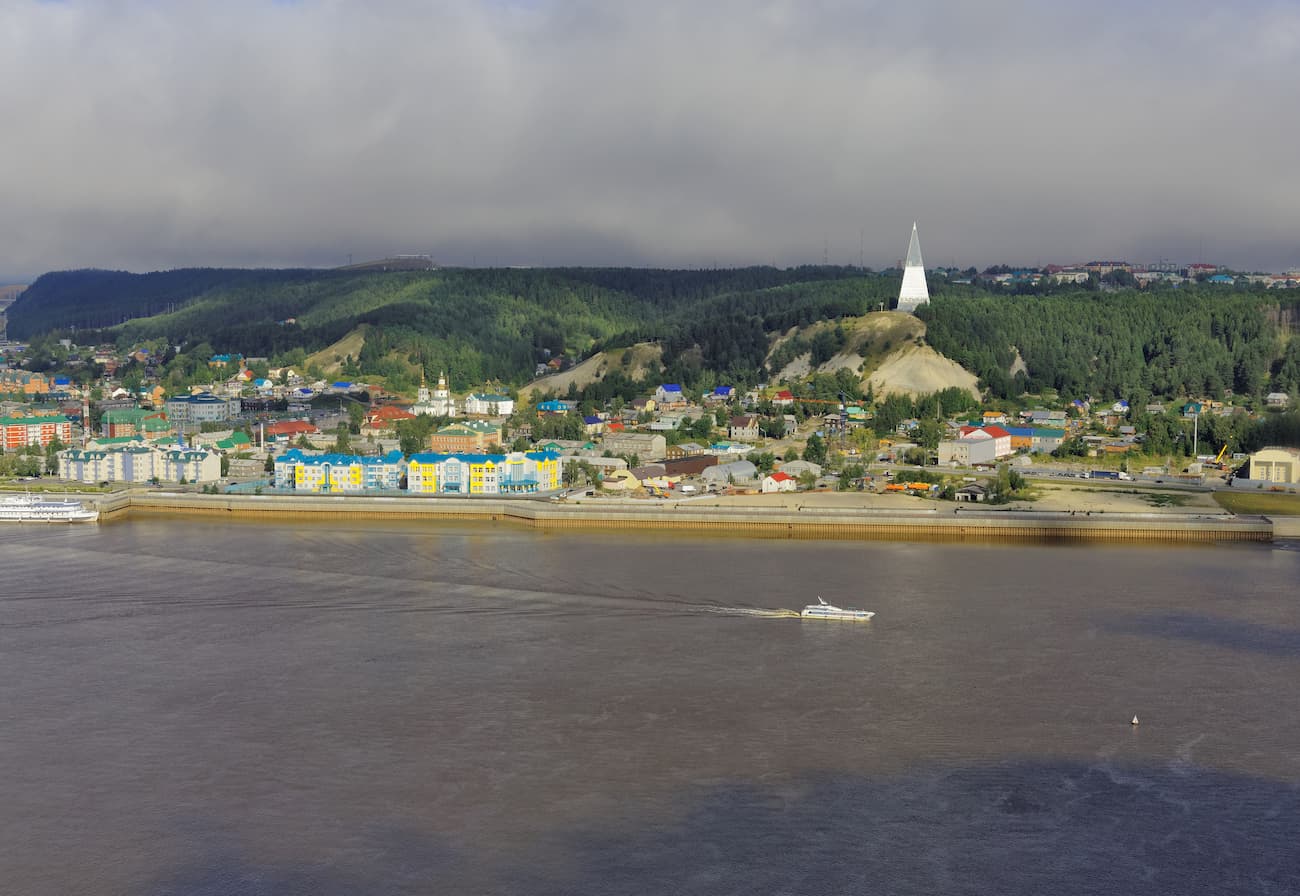
The city has several attractions. Mount Samarovskaya is probably the biggest natural and scientific wonder. It divides the city in two parts and causes many concerns for urban developers who always wonder whether this mountain can move making the buildings slide or even sink in.
Another beauty is the century-old cedar grove that is within the city limits. The grove is a part of the natural park Samarovsky Chugas. The word chugas in the language of the Khanty means a lonely hill in the low river floodplain.

The park is one of the main attractions of the city, it hosts an open-air ethnographic museum called the Torum Maa, a cultural and tourist complex called Archaeopark, a biathlon center. Kids and adults, nature lovers and fans of culture love this place dearly.
A memorial sign to Yugra's discoverers is installed on top of the Samarovsky Chugas. It is a tall stele pyramid divided into three portions. On the lower level, there is a restaurant, on the second level is a small museum, and on the third level there is an observation deck, 40 m above the ground, with a magnificent view of the Irtysh River and the river port. The pyramid is decorated by the bas-relief depicting the discoverers of the region, from the 16th-century Count Samara to the geologists of the 20th century.
Another trademark of Khanty-Mansiysk is the State Museum of Nature and Man. The museum hosts a gallery and a workshop of a famous artist G. Rayshev.
The city has a lot of small monuments generously spread around the city. There is the Khanty family resting on a camp, this monument is near the airport building. You can take a pic at the Golden Tambourine located at the intersection of Gagarin Street and Mira Street. Connoisseurs of culture should also visit the Sun – the Theatre of Ob-Ugrian Peoples, it is the world's first professional theatre of Khanty and Mansi peoples. And if you are travelling with kids, the Khanty-Mansiysk Puppet Theatre is a must-visit. In the period from May to October, you can take a boat ride to the confluence of two rivers – the Ob and the Irtysh. Yugra Service Co. operates such cruises, you can find more information locally at their address Tobolsk Trakt street 4, Khanty-Mansiysk .
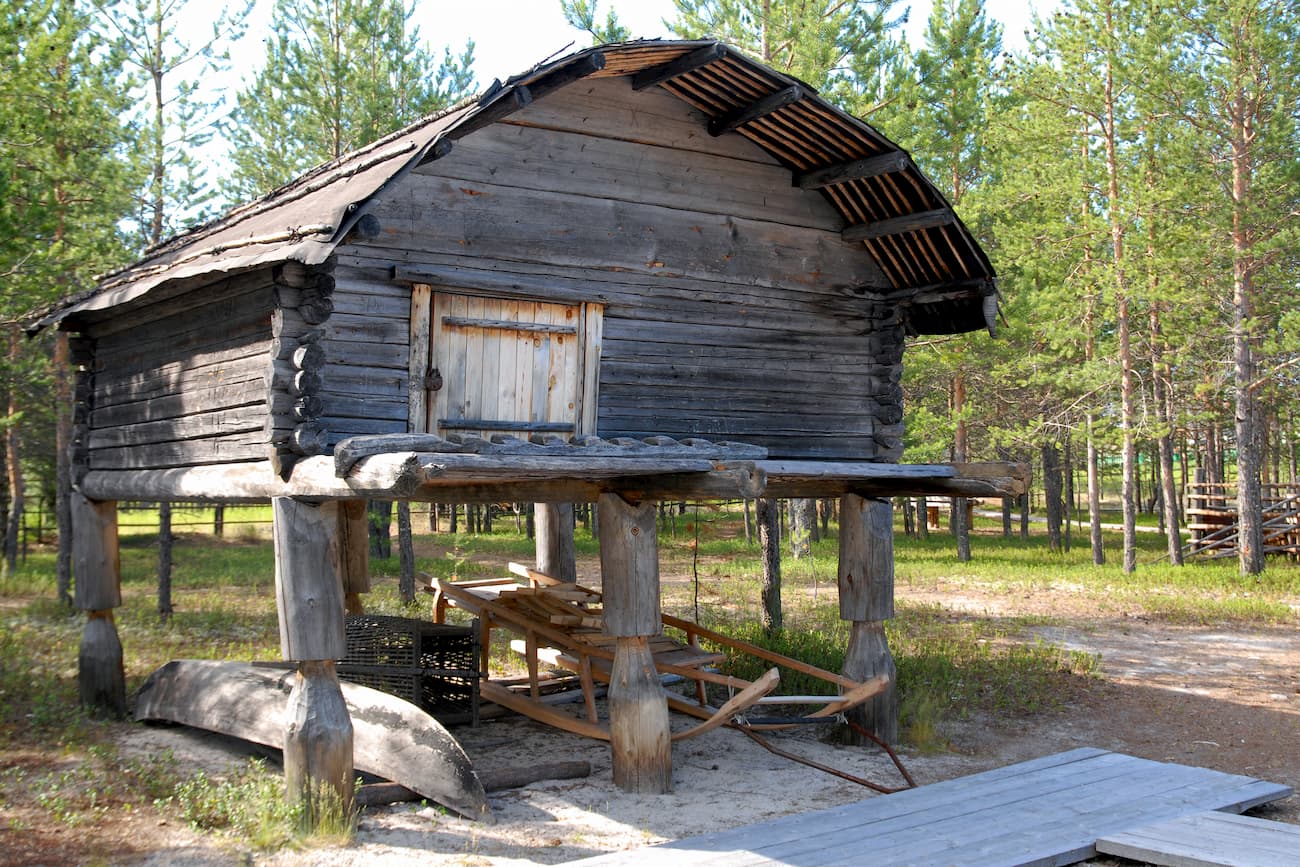
Explore Khanty-Mansiysk Autonomous Okrug – Ugra with the PeakVisor 3D Map and identify its summits .

PeakVisor Hiking Maps
Be a superhero of outdoor navigation with state-of-the-art 3D maps and mountain identification in the palm of your hand!
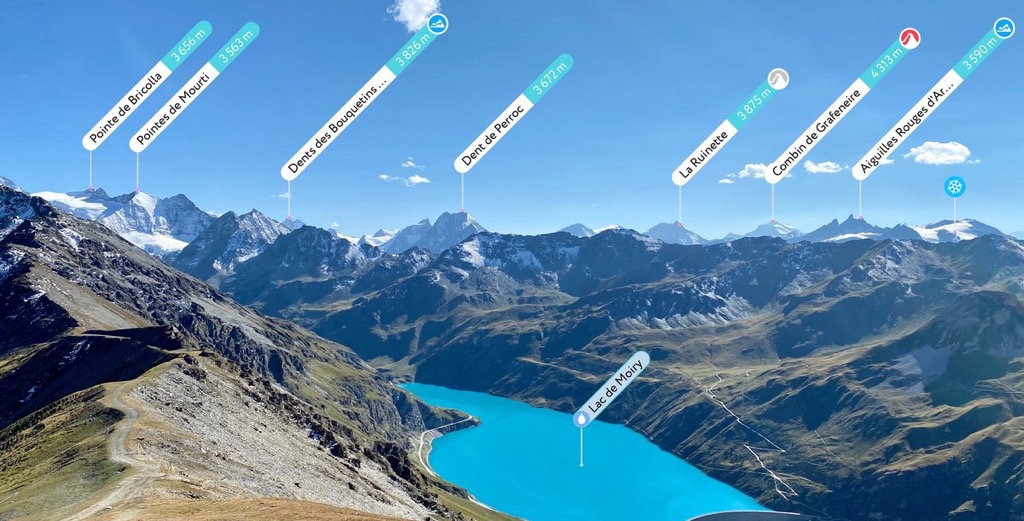
- FX+ 2 - 2023, Large
We’ll make this a great experience
It’s our mission to provide you with world-class hospitality every time you visit us online or in-store. We’ll always take care of you. It’s the Trek way.
30-day Unconditional Guarantee
If for any reason you’re not 100% happy with your online order from trekbikes.com, you can return it in like-new condition within 30 days. No questions asked.
Couldn't be happier
"I couldn't be happier. Easy deal, came in a couple of days. Only had to put on the bars and front wheel. Thank you, Trek!" -Rick
Best packaged bike
"Hands down the best packaged bike I've ever had shipped." - Ronald
Incredibly impressed
"I want to let you know how incredibly impressed I am with my entire Red Barn Refresh bike purchase experience...one of the best buying experiences I've ever had." - Jim
Accessories
How tall are you.
To measure your height, stand straight up, barefoot, with your back, heels, shoulders and head all touching a wall. While looking straight ahead, place a book or straight edge on your head and slowly push it against the wall. Your straight edge should be parallel with the floor. Mark the spot where the bottom of the book is touching the wall. The distance from the marked spot to the floor is your height.
What is your inseam?
How to measure: Stand barefoot with your back straight and against a wall. Tuck a ruler or something that extends to the floor between your legs. Using both hands, and keeping it level, pull the ruler up into your crotch as if you were sitting on the saddle. Measure the distance from the top edge of the ruler to the ground to find your inseam measurement. Your inseam is very important to your final bike size so please measure carefully.

IMAGES
VIDEO
COMMENTS
Stop pumping when you're within the range printed on the side of your tire. 10. Release the pump head by pressing the lever down and quickly pulling the head off the valve. If you're using a Presta valve, don't' forget to close it. 11. Secure your pump to the valve by pushing the pump head down on the valve as far as it can go.
FX 2 is a versatile hybrid bike for fitness, commuting, or riding for the fun of it! It has a lightweight Alpha Gold Aluminum frame, 24 speeds and a wide range of gearing that's great in hilly terrain, and tires that are both fast on the road and stable on paths and loose terrain. Compare. Color / Matte Trek Black.
tubeless vs tubes. Now some of this, we already know if you're on stock tires - they are 32mm and using tubes. If you're around 80kg (176lb), you might start with the max pressure on the rear tire as being around 70 psi, with the front tire about 10psi less. The idea that running tires at higher pressures will make them roll faster is ...
6. Secure your pump to the valve by pushing the pump head down on the valve as far as it can go. Then, lock the head by lifting the lever. 7. Wiggle the head. If you feel the valve moving inside, it's not secure enough and needs to be pushed down even more. 8. Once the pump is securely attached, begin pumping.
FX 2 Disc Gen 3. 298 Reviews / Write a Review. $749.99 $799.99. Model 5258267. Retailer prices may vary depending on location and delivery method. The final price will be shown in your cart. FX 2 Disc is a stylish and versatile hybrid bike with disc brakes that let you stop on a dime and ask for change, even when the weather isn't cooperating.
Pavement. Size. Pressure Range (psi/bar) Connection Hybrid. 700x35. 40-65/2.8-4.5. E6 Hard-Case Lite. 700x50.
Trek FX 2 Disc Equipped review: Unspectacular but effective. Sep 2022 · Benjamin Page. The Trek FX 2 Disc is a versatile all-rounder with surprising levels of comfort and stability. Highs. The frame has a great balance between responsiveness and comfort. Equipped for night riding, bikepacking or commuting.
Specs, reviews & prices for the 2021 Trek FX 2 Disc. Compare forks, shocks, wheels and other components on current and past bikes. View and share reviews, comments and questions on road bikes. Huge selection of road bikes from brands such as Trek, Specialized, Giant, Santa Cruz, Norco and more.
Trek FX Sport 6 review. Nov 2018 · Ian Osborne. High-class fitness bike with proven road technology and a classy component package. Buy if you want a capable, high-spec yet sensible-handling bike with a flat bar. Highs. Comfortable-yet-fun ride, IsoSpeed decoupler, lightweight, Shimano 105. Lows.
Trek's FX range of bikes is quite extensive, starting at the £500.00/$599.99 FX 1 and going all the way to the full-carbon £3,050.00/$2,799.99 FX Sport 6.
I had to go on a 50 mile ride for Boy Scouts and loved that too. For the past two months I have been riding my wife's small, pink, step-through bike (I am 6'5, lol). It has really gotten me back into the love of cycling! I just purchased a 2022 FX2 disc in the XL frame, and I am crazy excited to get back on the road with a proper sized bike ...
Find the proper tire pressure range on your tire's sidewall. If you're inflating 26-inch tires (common on comfort and off-road bikes), you may find that the pressure range is wider, say "35 to 60 psi." This is because these tires can be used on and off road. For the former, 60 psi is about right because it rolls optimally on pavement.
FX 2 Disc. Model 584151. Retailer prices may vary depending on location and delivery method. The final price will be shown in your cart. FX 2 Disc is a stylish and versatile hybrid bike with disc brakes that let you stop on a dime and ask for change, even when the weather isn't cooperating. Train, commute, or ride for fun with the lightweight ...
The Trek FX 2 Equipped Stagger, Trek FX 3 Gen 4, and Trek FX Sport 4 are all 700c fitness bikes with mid-range components and hydraulic disc brakes. The FX 2 Equipped Stagger has an aluminum fork and 700c wheels, while the FX Sport 4 has a carbon frame and higher gearing.
I believe the tires on the FX suggest a pressure between 60-95 PSI. For reference, the combined weight of my bike (FX with 32c tires), my stuff and me is ~160 - 170lbs and I usually ride on the road with the occasional gravel trail. So I run in the ballpark of 65 - 70 PSI. Reply. 29K subscribers in the TrekBikes community.
Nizhnevartovsk - Overview. Nizhnevartovsk is a city in Russia, an administrative center of Nizhnevartovsky district of the Khanty-Mansi autonomous okrug. It is the second largest city of the region. The population of Nizhnevartovsk is about 280,800 (2022), the area - 271 sq.km. The phone code - +7 3466, the postal codes - 628600-628615.
Khanty-Mansi Autonomous Okrug or simply Yugra is located in the heart of Russia - in the north of Western Siberia. It is the main oil and natural gas region of the country and one of the largest oil producing regions in the world (about 60% of Russian oil). Yugra climate is equivalent to the climate of the Far North.
49 Reviews / Write a Review. $1,999.97 $2,499.99. Model 5268342. Retailer prices may vary depending on location and delivery method. The final price will be shown in your cart. FX+ 2 is a lightweight city electric bike that's designed to make everyday excursions faster and more fun. It has an intuitive and natural feeling pedal assist system ...
The largest cities of Khanty-Mansi Autonomous Okrug - Yugra are Surgut (396,000), Nizhnevartovsk (280,800), Nefteyugansk (128,700), Khanty-Mansiysk (106,000), Kogalym (69,200), Nyagan (58,500). Today, only about 32,000 people are representatives of indigenous peoples: Khanty, Mansi and Nenets. Half of them live in the traditional way.
The Khanty-Mansiysk Autonomous Area (KhMAO) was established in 1930. Its name comes from two main northern indigenous peoples - the Khanty and the Mansi. From 1944 it was legally part of the Tyumen Region, but in 1993 the Area received autonomy and became a full-fledged territorial entity of the Russian Federation.
Discover your next great ride with FX 2 Disc Stagger Gen 3 - 2023, Small. See the bike and visit your local Trek retailer. Shop now!
Discover your next great ride with FX+ 2 - 2023, Large. See the bike and visit your local Trek retailer. Shop now!